This page is a work in progress as I add still-frames, behind-the- scenes photographs and other data to the core information kindly supplied and formatted by Dr Falk Schwarz, author of Farbige Schatten – Der Kameramann Robert Krasker.
Please note that the year beneath each film’s title and still-frame is the year of the film’s first release, not the year when it was in production and post-production or the year of its cinematography.
In this version of this page I am following the formatting kindly provided by Dr Falk Schwarz via his book’s manuscripts.
Some names here have the notation (uncredited) behind them.
Before films ended with several minutes’ worth of long rolling credits it was more common to reduce credits down to the bare minimum and many crew members were left out.
In other cases, cast or crew simply did not want their credits to appear onscreen for any of a number of reasons.
Paramount France aka Les Studios Paramount (operated between 1930 and 1932) in Joinville-le-Pont, Paris, France assisting and translating for cinematographer Philip Tannura there and then in England:
Le Rebelle

France 1931
Synopsis: Currently under research. French language version of The Virtuous Sin (1930).
Les Studios Paramount, released through Société Anonyme Française des Films Paramount (France, 1931), Films Paramount (Belgium); from the play Der General by: Lajos Zihaly; written by Martin Brown, Louise Long, Benno Vigny and Lajos Zilahy.
Director: Adelqui Migliar
Film type & format: Black and white, 1.20:1, 35mm.
Director of Photography: Philip Tannura; Camera Assistant: Robert Krasker (uncredited).
Cast: Suzy Vernon, Thomy Bourdelle, Paule Andral, Pierre Batcheff
Henry Prestat, Frédéric Mariotti, André Rehan, Jeanne Brazine, Georges La Cressonnière.
Duration: 85 minutes.
Premiere: 1931 (Turkey), 31 July 1931 (Paris, France), 4 September 1931 (Belgium), 18 January 1932 (Portugal).
Dates & locations: Filmed at Les Studios Paramount in Joinville-le-Pont, France, in 1930 and 1931.
Links
- IMDb – Le rebelle
- Wikipedia – The Rebel
Generalen
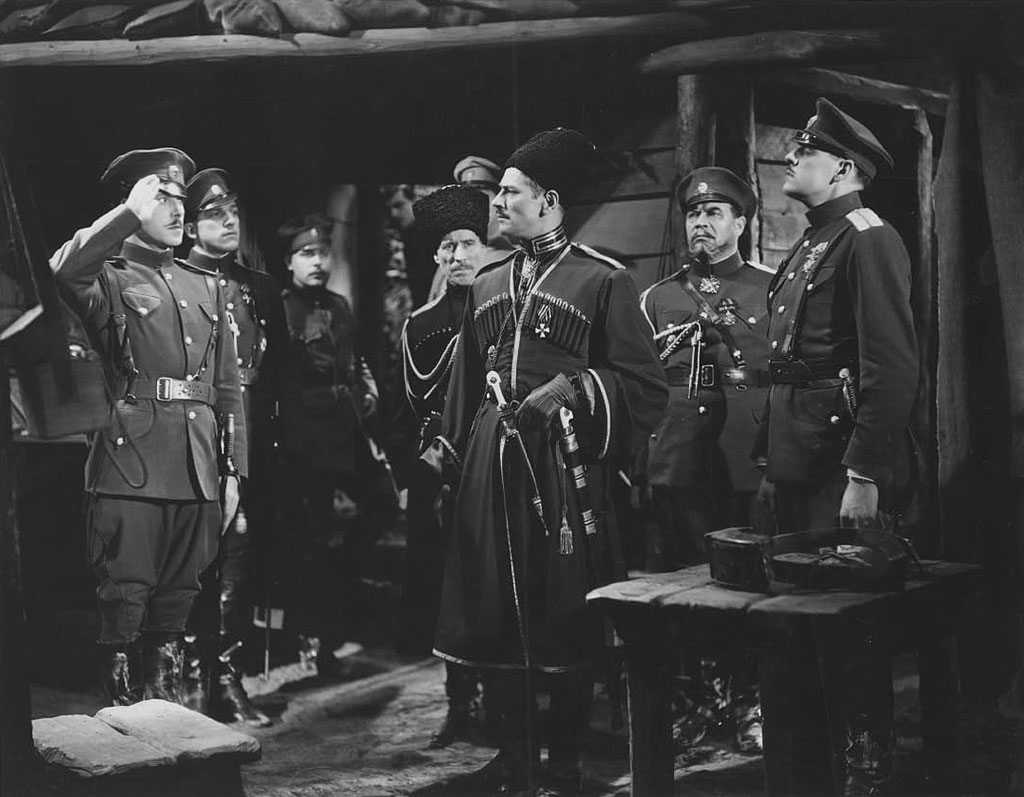
Also known as Kenraali
Sweden 1931
Synopsis: Maria, a young Russian student, is loved by Viktor Sabline, a Russian scientist. They marry and immediately afterwards, the World War breaks out and Viktor is drafted as lieutenant. – IMDb
Les Studios Paramount, released through Paramount Publix Corporation; from the play Der General by: Lajos Zihaly; written by Gustaf Bergman and Lajos Zilahy.
Director: Gustaf Bergman.
Film type & format: Black and white, 1.20:1, 35mm.
Director of Photography: Philip Tannura; Camera Assistant: Robert Krasker (uncredited).
Cast: Edvin Adolphson, Inga Tidblad, Paul Seelig, Karin Swanström, Nils Leander, Knut Martin, Georg Blomstedt, Hjalmar Lundholm, Hjalmar Peters, Hans Björnbo, Gunhild Lindholm.
Duration: 80 minutes.
Premiere: 16 April 1931 (Sweden), 2 November 1931 (Finland).
Dates & locations: Filmed at Les Studios Paramount in Joinville-le-Pont, France, in 1930 and 1931.
Links:
- IMDb – Generalen
- Wikipedia – Lajos Zihaly
Die Nacht der Entscheidung
{image goes here}
Also known as The Night of Decisions
Germany 1931
Synopsis: Currently under research. German language version of The Virtuous Sin (1930).
Les Studios Paramount, released through Paramount Publix Corporation (under research); from the play Der General by: Lajos Zihaly; written by Martin Brown, Louise Long, Benno Vigny and Lajos Zilahy.
Director: Dimitri Buchowetzki
Film type & format: Black and white, 1.20:1, 35mm.
Director of Photography: Philip Tannura; Camera Assistant: Robert Krasker (uncredited), Music: Karl Hajos (uncredited).
Cast: Conrad Veidt, Olga Tschechowa, Peter Voß, Trude Hesterberg, Alphons Fryland, Erik Werntgen, Emil Ritter, Frédéric Mariotti.
Duration: 76 minutes.
Premiere: 17 September 1931 (Germany), 2 November 1931 (Finland), 5 November 1931 (Hungary), 29 July 1932 (Denmark).
Dates & locations: Filmed at Les Studios Paramount in Joinville-le-Pont, France, in 1931.
Links
- IMDb – Die Nacht der Entscheidung
- Wikipedia – The Night of Decisions
Paramount-British in London, assisting Philip Tannura before accepting an offer from Alexander Korda to work for him at London Film Productions:
Service for Ladies
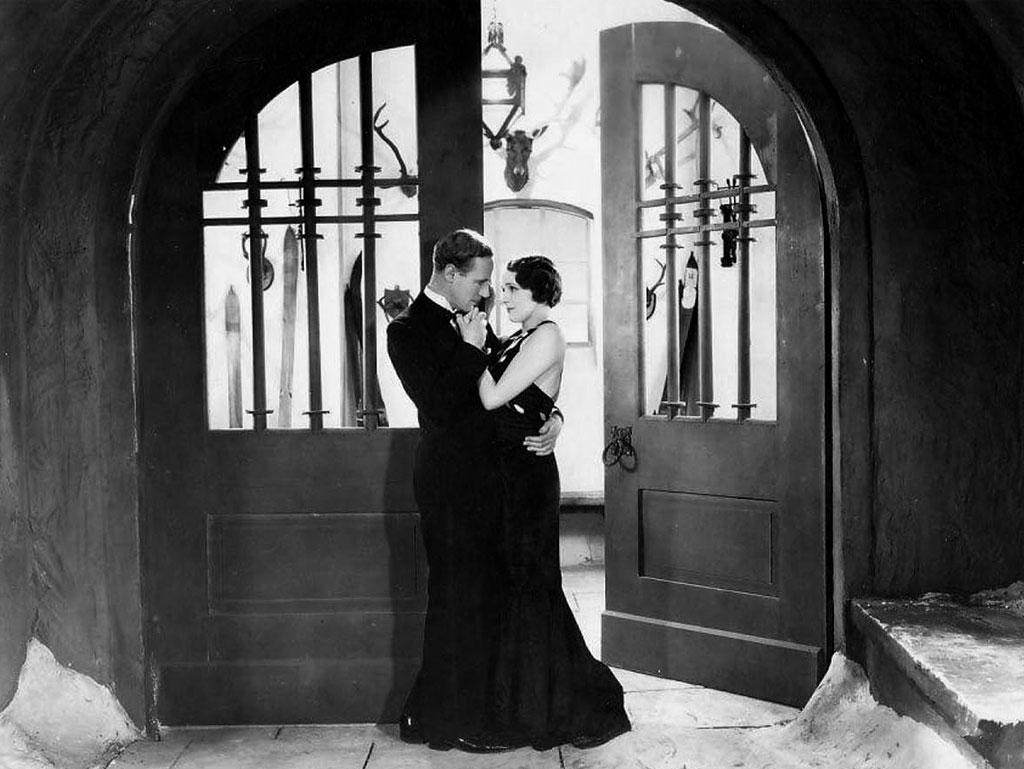
Also known as Reserved for Ladies, The Head Waiter
Great Britain 1932
Synopsis: A waiter poses as a prince to win a beautiful aristocrat. – TCM
Paramount-British; released through Paramount Publix Corporation; produced by Alexander Korda, from the novel The Head Waiter by: Ernest Vajda; written by Eliot Crawshay-Williams and Lajos Biro.
Director: Alexander Korda.
Film type & format: Black and white, 1.37:1.
Director of Photography: Philip Tannura; Camera Assistant: Robert Krasker (uncredited); Assistant Director: Stephen Harrison; Editor: Harold Young; Art Director: R. Holmes Paul; Designer: Alfred Junge; Music: Percival Mackey; Casting Director: Hugh Perceval.
Cast: Leslie Howard, Benita Hume, Morton Selten, Cyril Ritchard, George Grossmith Jr., Diana Churchill (uncredited), Annie Esmond, Jan Marugg, Elizabeth Allen, Ben Field, Eileen Munro (uncredited), Gilbert Davis (uncredited), Pearl Hay, Patrick Ludlow, Naomi Waters, Martita Hunt (uncredited), Estelle Thompson (Merle Oberon, uncredited).
Duration: 71 minutes.
Premiere: 14 January 1932 (UK), 20 June 1932 (US).
Dates & locations: Filmed between September and November 1931 at Elstree Studios, Borehamwood, Herfordshire, England, United Kingdom.
Links:
- IMDb – Reserved for Ladies
- TCM – Reserved for Ladies
- Wikipedia – Service for Ladies
London Film Productions in Denham, Buckinghamshire, England, starting by camera operating for Georges Périnal before becoming Director of Photography:
The Rise of Catherine the Great

Also known as Katharina die Große
Great Britain 1933
Synopsis: Straightforward biography of the Russian Empress, up to her assumption of the throne. – IMDb
London Film Productions; released through United Artists; produced by Alexander Korda and Ludovico Toeplitz; after the play The Czarina; written by Lajos Biro, Marjorie Deans, Melchior Lengyel, Arthur Wimperis.
Directors: Paul Czinner and Alexander Korda (uncredited).
Film type & format: Black and white, 1.37:1.
Director of Photography: Georges Périnal; Camera Operator: Robert LaPresle, Bernard Browne; Assistant Camera Operator: Robert Krasker; Music: Ernst Toch; Music Director: Muir Mathieson; Film Editor: Stephen Harrison, Harald Young; Art Director: Francis Hallam, Vincent Korda; Costumes: John Armstrong, B.J. Simmons; Production Manager: David B Cunynghame; Assistant to the Director: Geoffrey Boothby; Sound: A.W. Watkins.
Cast: Douglas Fairbanks Jr., Flora Robson, Elisabeth Bergner, Gerald du Maurier, Irene Vanbrugh, Joan Gardner, Dorothy Hale, Diana Napier, Gibb McLaughlin, Laurence Hanray, Allan Jeayes, Griffith Jones, Clifford Heatherley, Heron Carvie, William Henghan, Arnold Lucy.
Duration: 95 minutes.
Premiere: 9 February 1934; GB Release: 27 February 1934; US Release: 13 April 1934.
Dates & locations: Filmed at British and Dominon Studios, Borehamwood, Herfordshire, England.

Links
- IMDb – The Rise of Catherine the Great
- Wikipedia – The Rise of Catherine the Great
The Private Life of Don Juan

Also known as Das Privatleben des Don Juan
Great Britain 1934
Synopsis: When a jealous husband kills a fake Don Juan, the real thing sees a way to retire with grace. – TCM
London Film Productions; released through United Artists; produced by Alexander Korda after the play L’homme à la Rose by Henry Bataille; written by Frederick Lonsdale and Lajos Biro; Dialogue: Arthur Wimperis.
Directed by Alexander Korda.
Film type & format: Black and white, 1.37:1.
Director of Photography: Georges Périnal; Camera Operator: Robert LaPresle, Osmond Borradaile; Assistant Camera: Robert Krasker; Music: Ernst Toch, Michael Spoliansky; Music Director: Muir Mathieson; Film Editor: Stephen Harrison, Harold Young; Art Director: Vincent Korda, Francis Hallam; Costumes: Oliver Messel; Production Manager: David B. Cunynghame; 2nd Unit Director and Assistent Director: Geoffrey Boothby; Sound: A.W. Watkins; Special Effects: Ned Mann; Technical Advisor: Marquis de Portago.
Cast: Douglas Fairbanks Sr., Merle Oberon, Bruce Winston, Gina Malo, Benita Hume, Melville Cooper, Owen Nares, Heather Thatcher, Diana Napier, Joan Gardner, Gibson Gowland, Binnie Barnes, Claud Allister, Athene Seyler, Hindle Edgar, Natalie Paley, Patricia Hillard, Lawrence Grossmith, Clifford Heatherley, Morland Graham, Edmund Breon, Betty Hamilton, Hay Petrie.
Duration: 89 minutes.
GB Release: 10 September 1934; US Release: 30 November 1934; World Premiere: 28 August 1934, Venice Film Festival.
Locations: Filmed at British and Dominion Studios, Borehamwood, England.
Links
- IMDb – Things to Come
- Wikipedia – Things to Come
Things to Come

Great Britain 1935
Synopsis: The story of a century: a decades-long second World War leaves plague and anarchy, then a rational state rebuilds civilization and attempts space travel. – IMDb
London Film Productions; released through United Artists; produced by Alexander Korda; after the novel The Shape of Things to Come by H.G. Wells; written by H.G. Wells.
Directed by William Cameron Menzies.
Film type & format: Black and white, 1.37:1.
Director of Photography: Georges Périnal; Camera Operators: Robert Krasker, Bernard Browne (Assistant), Osmond Borradaile (Exteriors); Music: Arthur Bliss; Music Director: Muir Mathieson, Lionel Salter; Film Editor: Charles Crichton, Francis D. Lyon, William Hornbeck; Art Director: Vincent Korda, Frank Wells, John Bryan, Frederick Pusey, William Cameron Menzies; Costumes: John Armstrong, René Hubert, Cathleen Mann, Sam Williams; Production Manager: David B. Cunynghame; 2nd unit and assistant director: Geoffrey Boothby; Sound: A.W. Watkins, Desmond Dew; Special Effects: Lawrence W. Butler, Edward Cohen, Ned Mann, Ross Jacklin, George J. Teague, Wally Veevers, Harry Zech; Visual Effects: Jack Cardiff (Camera Operator Special Effects), W. Percy Day (Matte Painter), Peter Ellenshaw (Matte Painter); Special Sequences: Lazlo Moholy-Nagy; Aeronautical Adviser: Nigel Tangye.
Cast: Raymond Massey, Ralph Richardson, Edward Chapman, Margareta Scott, Cedric Hardwicke, Maurice Braddell, Sophie Stewart, Derrick de Marney, Ann Todd, Pearl Argyle, Allan Jeayes.
Duration: 100 minutes.
GB Release: 22 February 1936, Leicester Square Cinema, London; US Release: 24 April 1936.
Dates & locations: Filmed at Worton Hall Studios, Isleworth, and Denham Studios (exterior), Brooklands Aerodrome and a colliery in Wales from February 1935 to late autumn 1935.
Note: The British Society of Cinematographers was founded in 1949 and use of the initialism BSC would have begun then.
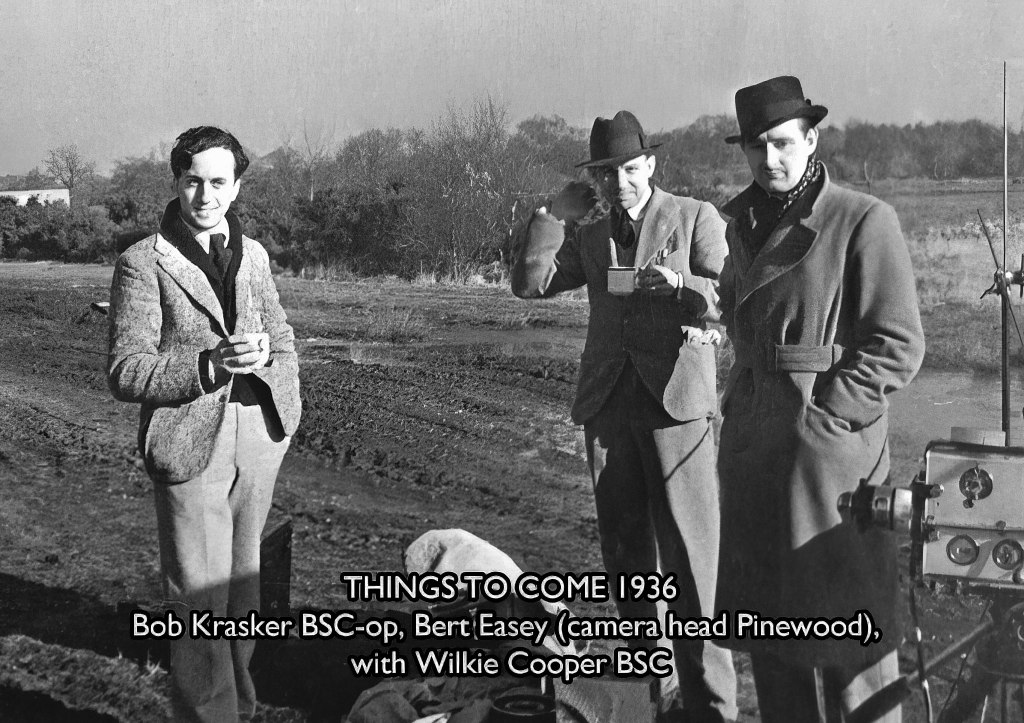
Links
- IMDb – Things to Come
- Wikipedia – Things to Come
Rembrandt

Great Britain 1936
Synopsis: The respected painter takes to drink and faces down scandal after his wife dies. – IMDb
London Film Productions; released through United Artists; produced by Alexander Korda; after the story by Carl Zuckmayer; written by June Head and Lajos Biro; Dialogue: Arthur Wimperis.
Directed by Alexander Korda.
Film type & format: Black and white, 1.37:1.
Director of Photography: Georges Périnal; Assistant Photography: Richard Angst; Camera Operator: Robert Krasker; Music: Geoffrey Toye; Music Director: Muir Mathieson; Editing: Francis D. Lyon, William Hornbeck, Eric Hodges; Art Director: Vincent Korda, Hal Waller; Costumes: John Armstrong; Makeup: Stuart Freeborn; Production Manager: Geoffrey Boothby, David B. Cunynghame; Sound: Amy Fisher, A.W. Watkins, Sash Fisher, John W. Mitchell; Stills: Edward Woods; Special Effects: Ned Mann; Visual Effects: W. Percy Day, Peter Ellenshaw; Technical Advisor: Johan de Meester.
Cast: Charles Laughton, Gertrude Lawrence, Elsa Lanchester, Edward Chapman, Walter Hudd, Roger Livesey, John Bryning, Sam Livesey, Herbert Lomas, Allan Jeayes, John Clements, Raymond Huntley.
Duration: 85 minutes.
GB Release: 6 November 1936; US Release: 21 November 1936.
Dates & locations: Filmed from June 1936 to September 1936 at Denham Studios, Buckinghamshire, England.
Links
Forget Me Not

Also known as Forever Yours
Great Britain 1936
Synopsis: A young British woman, tricked into believing she was used during a whirlwind romance, marries a gentle widowed Italian opera star, whose songs she and her first love shared. – IMDb
London Film Productions, Itala Film; released through United Artists; produced by Albert Giacalone and Alexander Korda, after the screenplay of Ernst Marischka; written by Hugh Gray and Arthur Wimperis.
Directed by Zoltan Korda.
Film type & format: Black and white, 1.37:1.
Director of Photography: Hans Schneeberger; Camera Operator: Robert Krasker; Music: Mischa Spoliansky; Music Director: Muir Mathieson; Editing: Henry Cornelius; 2nd Unit and Assistant Director: Stanley Irving; Sound: A.W. Watkins.
Cast: Benjamino Gigli, Joan Gardner, Ivan Brandt, Jeanne Stuart, Richard Gofe, Hugh Wakefield, Charles Carson, Allan Jeayes, Hay Petrie.
Duration: 72 minutes.
GB Release: 21 December 1936; US Release: 15 May 1937.
Location: Filmed at Denham Studios, Buckinghamshire, England.
Links
- IMDb – Forever Yours
- Wikipedia – Forget Me Not
Men Are Not Gods

Also known as Männer sind keine Götter
Great Britain 1936
Synopsis: A secretary to an eccentric drama critic is persuaded to alter a ruinous review of a Shakespearean actor and falls in love with him. – TCM
London Film Productions; released through United Artists; produced by Alexander Korda after a story by Walter Reisch; written by G.B. Stern and Iris Wright.
Directed by Walter Reisch.
Film type & format: Black and white, 1.37:1.
Director of Photography: Charles Rosher; Camera Operator: Robert Krasker; Music: Geoffrey Toye; Music Director: Muir Mathieson; Film Editor: Henry Cornelius, William Hornbeck; Art Director: Vincent Korda, Arthur Cornwall; Costumes: René Hubert; Production Manager: David B. Cunynghame, Imlay Watts; Assistant Director: Jack Clayton; Sound: R. Hobbs, A.W. Watkins; Special Effects: Ned Mann.
Cast: Miriam Hopkins, Gertrude Lawrence, Sebastian Shaw, Rex Harrison, A. E. Matthews, Val Gielgud, Laura Smithson, Lawrence Grossmith, Sybil Grove, Winifred Willard.
Duration: 90 minutes.
GB Release: 27 November 1936; US Release: 22 January 1937.
Location: Filmed at Denham Studios, Buckinghamshire, England.
Links
- IMDb – Men Are Not Gods
- Wikipedia – Men Are Not Gods
The Man Who Could Work Miracles

Also known as Der Mann, der die Welt verändern wollte
Great Britain 1936
Synopsis: An ordinary man suddenly finds that anything he says comes true. Or at least, almost anything. – IMDb
London Film Productions; released through United Artists; produced by Alexander Korda, After a short story by H.G. Wells; written by H.G. Wells and Lajos Biro.
Directed by Lothar Mendes and Alexander Korda (some scenes, uncredited).
Film type & format: Black and white, 1.37:1.
Director of Photography: Harold Rosson; Camera Operators: Robert Krasker, Bernard Browne, Maurice Forde; Music: Mischa Spoliansky; Music Director: Muir Mathieson; Film Editor: Philip Charlot, William Hornbeck; Art Director: Vincent Korda; Costumes: John Armstrong; Production Manager: David B. Cunynghame; 2nd Unit and Assistant Director: Imlay Watts; Sound: A.W. Watkins; Special Effects: Ned Mann, Laurence W. Butler, Edward Cohen, Harry Zech; Visual Effects: Jack Cardiff, W. Percy Day (Matte Painter), Peter Ellenshaw.
Cast: Roland Young, Ralph Richardson, Edward Chapman, Ernest Thesiger, Joan Gardner, Sophie Stewart, Robert Cochran, Lady Tree, Lawrence Hanray, George Zucco.
Duration: 82 minutes.
GB Release: 8 February 1937; US Release: 19 February 1937.
Locations: Filmed at Denham Studios, Worton Hall Studios, Isleworth and San Francisco.
Links
- IMDb – The Man Who Could Work Miracles
- Wikipedia – The Man Who Could Work Miracles
I, Claudius
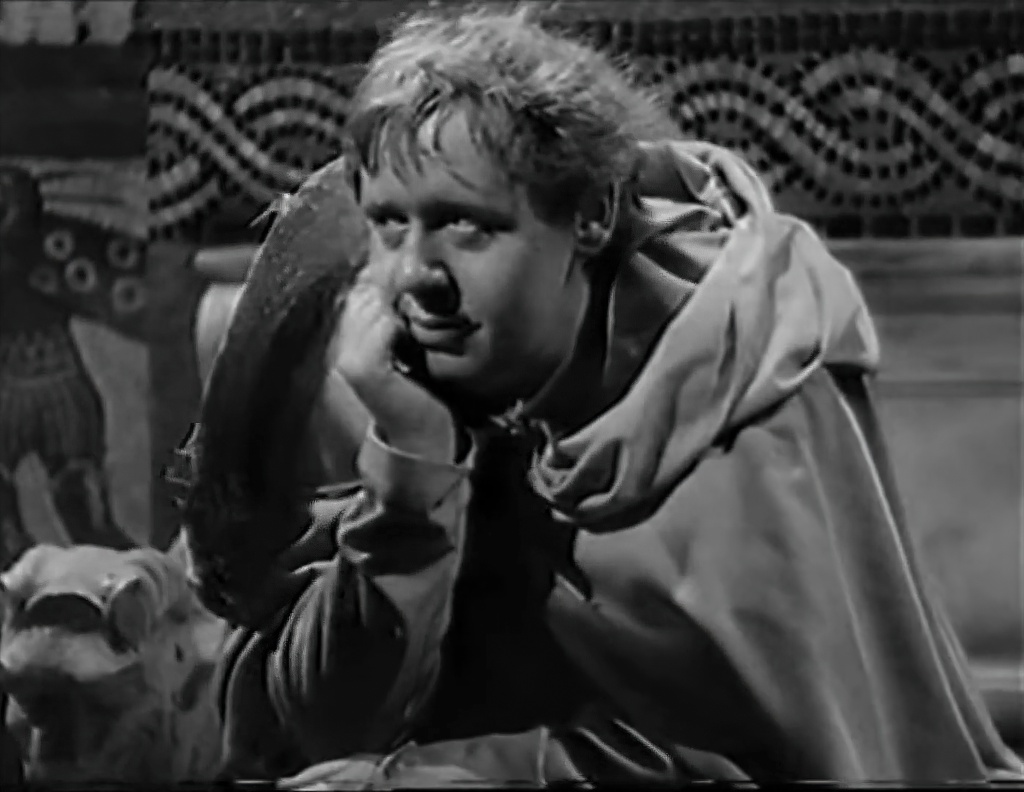
Great Britain 1937
Synopsis: The life and times of the Roman Emperor Claudius, 10 BC to 54 AD. – IMDb
London Film Productions; not released; produced by Alexander Korda, written after the Novel by Robert Graves by Lester Cohen, Josef von Sternberg, Lajos Biro, Carl Zuckmayer, Arthur Wimperis and Robert Graves.
Directed by Josef von Sternberg.
Film type & format: Black and white, 1.37:1.
Director of Photography: Georges Périnal; Camera Operator: Robert Krasker; Music: Arthur Bliss; Art Director: Vincent Korda, Ferdinand Bellan; Costumes: John Armstrong; Makeup: George Blackler; Sound: A.W. Watkins, John W. Mitchell; Choreographer: Agnes de Mille; Script: Eileen Corbett; Assistant Director: Geoffrey Boothby.
Cast: Charles Laughton, Merle Oberon, Emlyn Williams, Flora Robson, Alan Aynesworth, John Clements, Robert Newton, Leonora Corbett, Roy Emerton, Gina Evans, Frank Forbes-Robinson, Basil Gill, Morland Graham, Allan Jeayes.
Dates & locations: Filmed from 15 February 1937 to mid-March 1937 at Denham Studios, Buckinghamshire, England, unfinished.

Links
- IMDb – I, Claudius
- Wikipedia – I, Claudius
The Squeaker
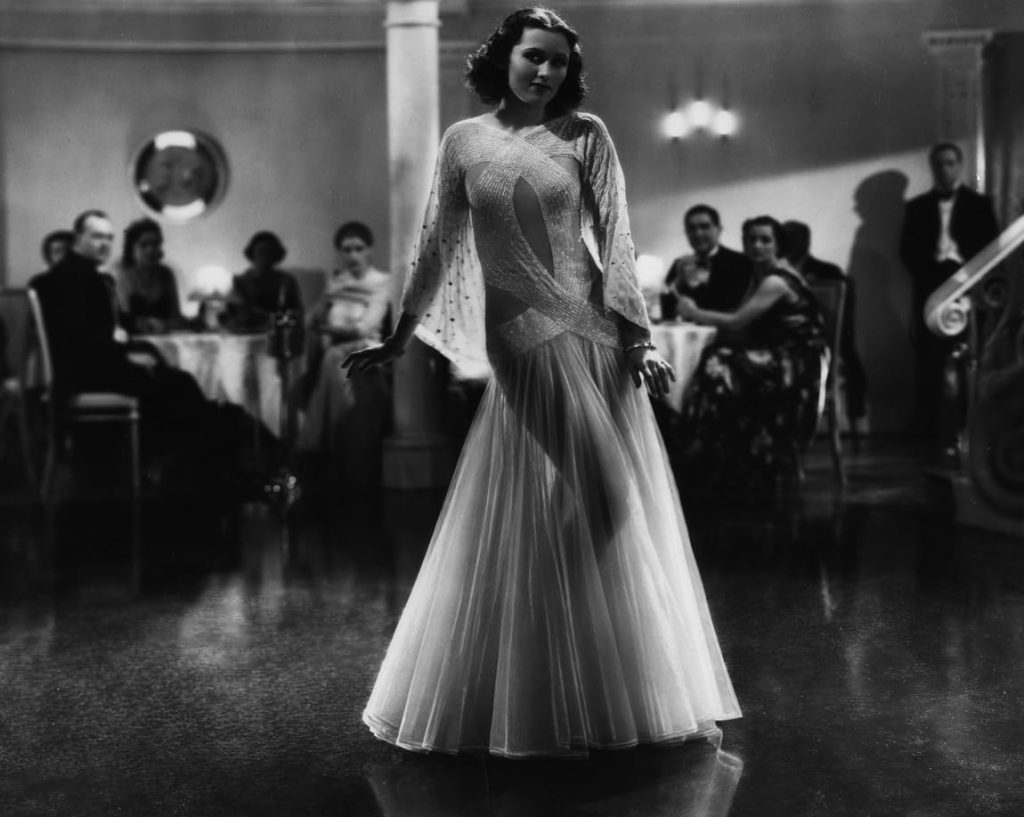
aka Murder on Diamond Row
Great Britain 1937
Synopsis: An out-of-favour Scotland Yard inspector hunts a killer diamond fence, The Squeaker. – IMDb
Denham Productions for London Film Productions; released through United Artists; produced by Alexander Korda; after the Novel by Edgar Wallace; written by Ted Berkman and Bryan Edgar Wallace.
Directed by William K. Howard.
Film type & format: Black and white, 1.37:1.
Director of Photography: Georges Périnal; Camera Operator: Robert Krasker; Music: Miklos Rosza; Music Director: Muir Mathieson, Lionel Salter; Film Editor: Jack Dennis, Russell Lloyd; Art Director: Vincent Korda, Arthur Cornwall, Alec Waugh; Production Manager: David B. Cunynghame; Sound: A.W. Watkins; 2nd Unit and Assistant Director: Wilfred O’Kelly.
Cast: Edmund Lowe, Sebastian Shaw, Ann Todd, Tamara Desni, Robert Newton, Allan Jeayes, Alastair Sim, Stewart Rome, Mabel Terry-Lewis, Gordon McLeod.
Duration: 77 minutes.
GB Release: 6 November 1937; US Release: 10 December 1937.
Dates & locations: Filmed in spring and summer 1937 at Denham Studios, Buckinghamshire, England.
Links
- IMDb – Murder on Diamond Row
- Wikipedia – The Squeaker
Over The Moon
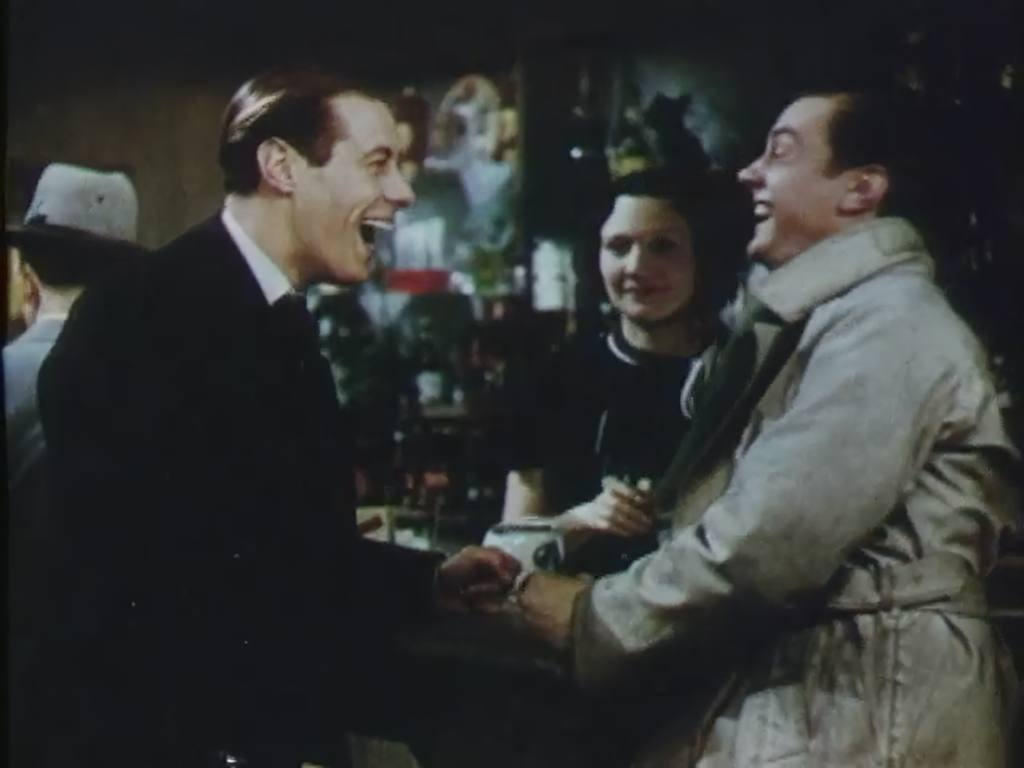
Also known as Die Millionenbraut
Great Britain 1937
Synopsis: A surprise inheritance breaks up a once-impoverished noblewoman and a doctor. – TCM
Denham Film Productions for London Film Productions; released through United Artists; produced by Alexander Korda; after a story by Robert E. Sherwood and Lajos Biro; written by Anthony Pellissier and Alec Coppel; Dialogue: Arthur Wimperis.
Directed by Thornton Freeland and William K. Howard.
Film type & format: Technicolor, 1.37:1.
Director of Photography: Harry Stradling, Sr.; Camera Operator: Jack Hildyard; Exterior Photography in Yorkshire and without actors in Monte Carlo, Arosa, Venice: Robert Krasker; Music: Mischa Spoliansky; Music Director: Muir Mathieson; Film Editor: Pat Wooley, Russell Lloyd, William Hornbeck; Set Director: Vincent Korda; Costumes: René Hubert; Production Manager: David B. Cunynghame; 2nd Unit and Assistant Director: Jack Clayton; Sound: A.W. Watkins; Technicolor Director: Natalie Kalmus.
Cast: Merle Oberon, Rex Harrison, Robert Douglas, Ursula Jeans, Louis Borell, Zena Dare, Peter Haddon, David Tree, Mackenzie Ward, Elizabeth Welch, Carl Jaffe, Herbert Lomas, Wilfrid Shine, Gerald Nodin.
Duration: 78 minutes.
GB Release: 19 February 1940; US Release: 29 March 1940.
Dates & locations: Filming began in 1937 in Denham, Buckinghamshire, England, and was finished with interruptions in 1939.
Links
- IMDb – Over the Moon
- Wikipedia – Over the Moon
The Drum

Also known as Gefahr am Doro-Paß
Great Britain 1937
Synopsis: An Indian prince tries to save his British masters from a deadly revolt. – TCM
London Film Productions, Alexander Korda Films; released through United Artists; produced by Alexander Korda; from Lajos Biro’s adaptation of the novel by A.E.W. Mason; written by Arthur Wimperis, Patrick Kirwan, Hugh Gray.
Directed by Zoltan Korda.
Film type & format: Technicolor, 1.37:1.
Director of Photography: Georges Périnal, Osmond Borradaile (Indian location scenes); Camera Operator: Robert Krasker; Focus Puller: Christopher Challis, Geoffrey Unsworth Music: John Greenwood, Miklos Rosza; Music Director: Muir Mathieson; Film Editor: Henry Cornelius, William Hornbeck, Maurice Harley; Art Director: Vincent Korda, Ferdinand Bellan; Costumes: René Hubert; Production Manager: David B. Cunynghame; Production Assistant: André de Toth; Sound: A.W. Watkins; Visual Effects: W. Percy Day, Peter Ellenshaw, Edward Cohen; Technical Advisers: Brigadier Hector Campbell, F.D. Henslowe; Technicolor Photographic Adviser: Aldo Ermini; Technicolor Color Director: Natalie Kalmus.
Cast: Sabu, Raymond Massey, Roger Livesey, Valerie Hobson, David Tree, Desmond Taster, David Tree, Francis L. Sullivan, Archibald Batty, Frederick Culley, Amid Taftazani, Lawrence Baskcomb, Roy Emerton, Ralph Truman.
Duration: 104 minutes.
GB Release: 9 April 1938; US Release: 30 September 1938.
Dates & locations: Filmed from late summer 1937 at Denham Studios, then Harlech, Gwynedd and Chitra, Jammu and Kashmir, India.
Links
The Challenge
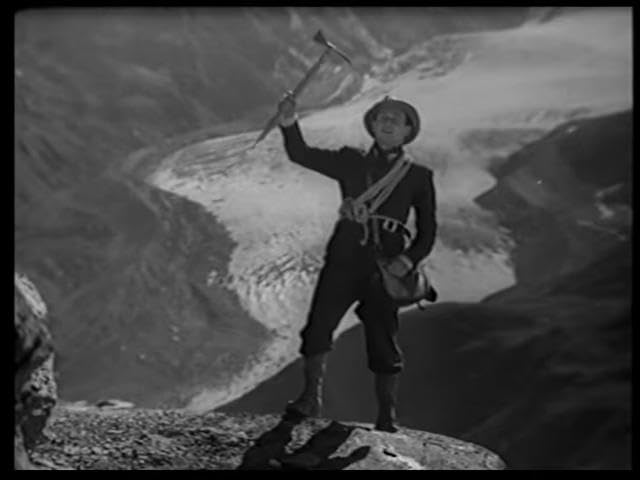
aka Der Berg ruft
Great Britain 1937
Synopsis: Dramatization of the first climbing of the Matterhorn in 1865. – IMDb
Denham Film Productions for London Film Productions; co-produced with Luis Trenker Film, Munich; released through United Artists; produced by Günther Stapenhorst and Alexander Korda; from a scenario by Patrick Kirwan and Milton Rosmer; written by Emeric Pressburger.
Directed by Milton Rosmer and Luis Trenker (Alpine sequences).
Film type & format: Black and white, 1.37:1.
Director of Photography: Georges Périnal (Studio), Albert Benitz (Alpine Sequences with English actors), also used exterior sequence shot by Walter Riml, Klaus von Rautenfeld; Camera Operator: (studio): Robert Krasker; Music: Allan Gray; Music Director: Muir Mathieson; Film Editor: Edward B. Jarvis; Art Director: Vincent Korda, Frederick Pusey; Production Manager: Harold Cox; Sound: A.W. Watkins, John W. Mitchell; Continuity: Phyllis Ross.
Cast: Luis Trenker, Robert Douglas, Frank Birch, Geoffrey Wardwell, Moran Caplat, Lyonel Watts, Mary Clare, Fred Groves, Joan Gardner, Lawrence Baskcomb, Ralph Truman, Reginal Jarman.
Duration: 75 minutes.
GB Release: 14 May 1938.
Dates & locations: Filmed at Denham Studios, Buckinghamshire, England and by Benitz at Matterhorn, Zermatt and Riffelberg Inn, (Switzerland). English version of German film: Der Berg ruft.
Links
- IMDb – The Challenge
- Wikipedia – The Challenge
The Four Feathers

Also known as Vier Federn
Great Britain 1938
Synopsis: A timid 1880s British Army officer resigns, burning his last-day summons to war in Egypt. Accusing him of cowardice, his girlfriend and three friends give him white feathers. To gain redemption, he shadows his friends to save their lives. – IMDb
London Film Productions; released through United Artists; produced by Alexander Korda and Irving Asher; from the novel by A.E.W. Mason; written by R.C. Sheriff; additional Dialogues by Lajos Biro and Arthur Wimperis.
Directed by Zoltan Korda.
Film type & format: Technicolor, 1.37:1.
Director of Photography: Georges Périnal; Camera Operators: Robert Krasker, who fell ill with malaria and was flown back from Sudan to England; Assistant Camera: Henty Henty-Creer; Clapperloader: John Godar; Music: Miklos Rosza; Music Director: Muir Mathieson; Film Editor: Henry Cornelius, William Hornbeck; Art Director: Vincent Korda, Frederick Pusey, Ferdinand Bellan; Costumes: Godfrey Brennan, René Hubert; Production Manager: David B. Cunynghame; Sound: A.W. Watkins, H.G. Cape, John Cook, John W. Mitchell; Visual Effects: W. Percy Day, Peter Ellenshaw; Technical and Military Adviser: Capt. D. Anderson, Lt. Col. Stirling; Technicolor Color Director: Natalie Kalmus; 2nd Unit in Sudan: Director: Geoffrey Boothby; Production Assistant: André de Toth and Charles David; Photography: Osmond Borradaile and Jack Cardiff; Operator: Wilkie Cooper; Assistant: Geoffrey Unsworth; Clapper Loader: Wally Beavers.
Cast: John Clements, Ralph Richardson, C. Aubrey Smith, June Duprez, Allan Jeayes, Jack Allen, Donald Gray, Frederick Culley, Clive Baxter, Robert Rendel, Archibald Batty, Derek Elphinstone, John Laurie.
Duration: 130 minutes.
GB Release: 20 April 1939; US Release: 4 August 1939.
Dates & locations: Filmed at Denham Studios, England, and for three months from 1938 in Sudan.

Links
- IMDb – The Four Feathers
- Wikipedia – The Four Feathers
The Thief of Bagdad

Also known as Der Dieb von Bagdad
Great Britain 1939
Synopsis: After being tricked and cast out of Bagdad by the evil Jaffar, King Ahmad joins forces with a thief named Abu to reclaim his throne, the city, and the Princess he loves. – IMDb
London Film Productions; released through United Artists; produced by Alexander Korda; Assistant Producers: Zoltan Korda, William Cameron Menzies; written by Miles Malleson and Lajos Biro.
Directed by Ludwig Berger, Michael Powell, Tim Whelan, and uncredited: Alexander Korda, Zoltan Korda, William Cameron Menzies.
Film type & format: Technicolor, 1.37:1.
Director of Photography: Georges Périnal (AA); Exterior Photography: Osmond Borradaile; Camera Operators: Robert Krasker (Operator to Périnal), Henty Henty-Creer (Operator to Borradaile), Cliff Shirpser (Assistant Technicolor); Chief Electrician: Bill Wall; Music: Miklos Rosza; Music Director: Muir Mathieson; Film Editor: Charles Crichton, William Hornbeck, Peter R. Hunt; Art Director: Vincent Korda (AA), Ferdinand Bellan, William Cameron Menzies, Frederick Pusey; Costumes: John Armstrong, Oliver Messel, Marcel Vertès; Production Manager: David B. Cunynghame; Production Assistant: André de Toth; 2nd Unit and Assistant Director: Jack Clayton; Makeup: Stuart Freeborn, Tom Shenton; Sound: A.W. Watkins, John W. Mitchell, Jack Whitney (AA) (Special Sound-Effects); Special Effects: W. Percy Day, Lawrence W. Butler (AA), Tom Howard, Johnny Mills, Wally Beavers (Matte Artist); Assistant Director: Geoffrey Boothby, Charles David; Technicolor Director: Natalie Kalmus; Fight Choreographer: Ralph Faulkner.
Cast: Conrad Veidt, Sabu, June Duprez, John Justin, Rex Ingram, Miles Malleson, Morton Selten, Mary Morris, Bruce Winston, Hay Petrie, Adelaide Hall, Roy Emerton, Allan Jeayes, Glynis Johns, John Salew, Norman Pierce, Frederik Burtwell, Otto Wallen, Henry Hallett, Irmgard Spolianksy, Leslie Phillips, Cleo Laine.
Duration: 106 minutes.
GB Release: 25 December 1940; US Release: 25 December 1940.
Dates & locations: Filmed at Denham Studios, England, Gunwalloe, Cornwall, Sennen Cove, Land’s End, Cornwall, Pembrokshire Coast, Wales, Grand Canyon, USA, Bryce Canyon, USA, Hollywood Center Studios, United Artists Studios, Hollywood from June 1939 to February 1940.
Links
- IMDb – The Thief of Bagdad
- Wikipedia – The Thief of Bagdad
Old Bill and Son

Great Britain 1940
Synopsis: World War I veteran Bill is inspired to re-enlist in 1939, and ends up serving with his son. – IMDb
Legeran Films for London Film Productions; released through General Film Distributors; produced by Harold Boxall and Josef Somlo; after the story Old Bill; written by Bruce Bairnsfather, Ian Dalrymple and Derek N. Twist; Dialogue: Arthur Wimperis.
Directed by Ian Dalrymple.
Film type & format: Black and white, 1.37:1.
Director of Photography: Georges Périnal; Camera Operator: Robert Krasker; Music: Richard Addinsell; Music Director: Muir Mathieson, Roy Douglas; Film Editor: Charles Crichton, John Guthrie; Art Director: Vincent Korda, Norman Delaney; 2nd Unit and Assistant Director: Geoffrey Boothby; Sound: John Cook, A.W. Watkins.
Cast: Morland Graham, John Mills, Mary Clare, Renee Huston, René Ray, Janine Darcey, Gus McNaughton, Ronald Shiner, Manning Whiley, Roland Culver, Donald Stuart, Nicholas Phipps, Allan Jeayes.
Duration: 96 minutes.
GB Release: 3 March 1941.
Location: Filmed at Denham Studios, Buckinghamshire, England.
Links
- IMDb – Old Bill and Son
- Wikipedia – Old Bill and Son
Dangerous Moonlight

Also known as Suicide Squadron
Great Britain 1941
Synopsis: During World War II, an American newswoman falls for a Polish piano virtuoso… who wants to go back and fight. – IMDb
RKO Radio British Productions; released through RKO; produced by William Sistrom; written by Terence Young, Rodney Ackland and Brian Desmond Hurst.
Directed by Brian Desmond Hurst (action scenes directed by Terence Young).
Film type & format: Black and white, 1.37:1.
Director of Photography: Georges Périnal; Camera Operator: Robert Krasker (uncredited); Music: Richard Addinsell (Warsaw Concerto); Music Director: Muir Mathieson, Roy Douglas, Louis Kentner (piano double for Walbrook, uncredited); Film Editor: Alan Jaggs; Art Director: John Bryan; Costumes: Cecil Beaton; Production Manager: Philip Brandon; Sound: John Cook, A.W. Watkins; Continuity: Phyllis Ross.
Cast: Anton Walbrook, Sally Gray, Derrick de Marney, Cecil Parker, Percy Parsons, Kenneth Kent, J.H. Roberts, Guy Middleton, John Laurie, Frederick Valk, O.B. Clarence, James Pirrie.
Duration: 98 minutes.
GB Release: 26 June 1941.
Location: Filmed at Denham Studios, Buckinghamshire, England.
Links
- IMDb – Suicide Squadron
- Wikipedia – Dangerous Moonlight
Rose of Tralee
Great Britain 1941
Synopsis: Paddy, an Irish singer heads to America to seek fame and fortune. Once successful he returns home to search for his family. He joins The Royal Air Force. – IMDb
Butcher’s Film Service production and release; produced by F.W. Baker; written by Kathleen Butler, H.F. Maltby, Oswald Mitchell, Kathleen Tyrone, Ian Walker.
Directed by Germain Burger.
Film type & format: Black and white, 1.37:1.
Director of Photography: Geoffrey Faithfull; Second Camera: Robert Krasker; Associate Photographer: Jack Parker; Music Director: Percival Mackey; Assistant Director: Donald Weeks; Editor: A. Charles Knott; Art Director: Andrew Mazzei; Production Manager: E.S. Laurie; Sound: George Burgess, Stan Jolly.
Cast: John Longden, Lesley Brook, Angela Glynne, Mabel Constanduros, Talbot O’Farrell, Gus McNaughton, George Carney, Virginia Keiley, Iris Vandeleur, Morris Harvey.
Duration: 77 minutes.
GB Release: 1942.
Location: Filmed at Riverside Studios, Hammersmith, London, England.
Links
- IMDb – Rose of Tralee
- Wikipedia – Rose of Tralee
The Saint Meets the Tiger

Great Britain 1941
Synopsis: The last words uttered by by a conscience-stricken crook dying on the Saint’s doorstep lead the detective in pursuit of gold smugglers and the master crook known as the Tiger. – IMDb
RKO Radio British Productions; released through RKO; produced by William Sistrom; after the novel Meet the Tiger by Leslie Charteris; written by Leslie Arliss, Wolfgang Wilhelm and James Seymour.
Directed by Paul L. Stein.
Film type & format: Black and white, 1.37:1.
Director of Photography: Robert Krasker; Camera Operator: Harry Gillam; Music: Bretton Byrd, John Greenwood, Miklos Rosza, Roy Webb; Editing: Ralph Kemplen; Art Director: Paul Sheriff; Production Manager: Philip Brandon; Costumes: Honoria Plesch; Sound: John Cook, A.W. Watkins.
Cast: Hugh Sinclair, Jean Gillie, Gordon McLeod, Clifford Evans, Wyllie Watson, Dennis Arundell, Charles Victor, Louise Hampton, John Salew.
Duration: 79 minutes.
GB Release: 8 December 1943; US Release: 29 July 1943.
Location: Filmed at Denham Studios, Buckinghamshire, England.
Links
- IMDb – The Saint Meets the Tiger
- Wikipedia – The Saint Meets the Tiger
One of Our Aircraft is Missing

Great Britain 1942
Synopsis: During a raid on Germany a British bomber crew is forced to bail out after their plane is damaged. They land in Holland and are aided by Dutch civilians. – IMDb
The Archers Film Productions for British National Film Company; released through Anglo-American Film Corporation; produced by John Corfield, Stanley Haynes, Michael Powell, Emeric Pressburger with the cooperation of the Royal Air Force, the Air Ministry and the Royal Netherland Government London; written by Michael Powell and Emeric Pressburger.
Directed by Michael Powell.
Film type & format: Black and white, 1.37:1.
Director of Photography: Ronald Neame; Associate Photographer: Robert Krasker; Camera Operator: Guy Green; Clapper Boy: Jim Body; Model Shots of Raid over Stuttgart: Frederick Ford; Film Editor: David Lean, Thelma Myers-Connell; Art Director: David Rawnsley; Production Manager: Sydney Streeter; Production Secretary: Joan Page; Sound: C.C. Stevens, A.W. Watkins; Special Effects: Douglas Woolsey; Continuity: Betty Curtis; Assistant to Mr Powell: Bill Paton; Technical Advisor: James P. Power; Associate Director: John Seabourne, Sr.; Technical Advisor: M. Sluyser.
Cast: Godfrey Tearle, Eric Portman, Hugh Williams, Bernard Miles, Hugh Burden, Emrys Jones, Pamela Brown, Joyce Redman, Googie Withers, Hay Petrie, Selma Vas Diaz, Peter Ustinov, Robert Helpmann.
Duration: 106 minutes.
GB Release: 27 June 1942.
Dates & locations: Filmed from 11.08.1941 to March 1942 in Boston in Lincolnshire and The Fens and The Wash, East Anglia, Riverside Studios London and Denham Studios, Buckinghamshire, England.
Links
- IMDb – One of Our Aircraft is Missing
- Wikipedia – One of Our Aircraft is Missing
The Gentle Sex

Great Britain 1942
Synopsis: The stories of seven gentle British girls who decide to do their bit and help out during World War II. – IMDb
Two Cities Films/Concanen Productions; released through General Film Distributors; produced by Derrick de Marney and Leslie Howard; Associate Producer: Geoffrey Boothby; based on the story Observations of a Mere Man by Moie Charles; written by Elizabeth Baron, Moie Charles, Doris Langley Moore, Roland Pertwee (uncredited), Aimée Stuart.
Directed by Leslie Howard and Maurice Elvey (uncredited).
Film type & format: Black and white, 1.37:1.
Lighting Cameraman (Director of Photography): Robert Krasker; Operators: Cyril J. Knowles, Ray Sturgess; Music: John Greenwood; conducted by: Muir Mathieson; played by the London Symphony Orchestra; Film Editor: Charles Saunders; Casting: Irene Howard; Art Director: Paul Sheriff; Set Director: Carmen Dillon, C.P. Norman; Production Manager: Vincent Permaine; Production Consultant: Adrian Brunel; Makeup: Marjorie Whittle; 2nd Unit and Assistant Director: Cecil Gurney; Recording Director: A.W. Watkins; Sound Mixer: Charles Tasto; Visual Effects: Derrick Williams; Military Advisor: Senior Commander Pratt; Production Secretary: Renée Glynne.
Cast: Joan Gates, Jean Gillie, Joan Greenwood, Joyce Howard, Rosamund John, Lilli Palmer, Barbara Waring, John Justin, Mary Jerrold, John Laurie, Elliott Mason, Harry Welchman, Miles Malleson.
Duration: 89 minutes.
GB Release: 15 April 1943.
Locations: Filmed in Carlisle in Cumbria and Denham Studios, Buckinghamshire, England.
Links
- IMDb – The Gentle Sex
- Wikipedia – The Gentle Sex
The Lamp Still Burns

Also known as Heilige Feuer
Great Britain 1943
Synopsis: A tribute to the important work of female nurses during World War II. – IMDb
Two Cities Film Productions; released through General Film Distributors; produced by Leslie Howard and Phil C. Samuel; after the novel One Pair of Feet by Monica Dickens; written by Elizabeth Baron, Charles Nelson, Roland Pertwee.
Directed by Maurice Elvey.
Film type & format: Black and white, 1.37:1.
Director of Photography: Robert Krasker; Camera Operator: Jack Hildyard; Music: John Greenwood; Music Director: Muir Mathieson; Film Editor: Frederik Wilson; Art Director: Alex Vetchinsky; Casting: Irene Howard; Production Manager: Vincent Permaine; 2nd Unit and Assistant Director: William N. Boyle, Denis O’Dell; Sound: John Dennis; Technical Advisors: C.H. Alexander, Capt. H. Brierley.
Cast: Rosamund John, Stewart Granger, Godfrey Tearle, Sophie Stewart, Cathleen Nesbitt, Margaret Vyner, John Laurie, Joan Maude, Mignon O’Doherty, Leslie Dwyer.
Duration: 90 minutes.
GB Release: 29 November 1943.
Location: Filmed at Denham Studios, Buckinghamshire, England.
Links
- IMDb – The Lamp Still Burns
- Wikipedia – The Lamp Still Burns
The Chronicle History of King Henry the Fift with His Battell Fought at Agincourt in France

Also known as Henry V, König Heinrich V
Great Britain 1943–44
Synopsis: In the midst of the Hundred Years’ War, the young King Henry V of England embarks on the conquest of France in 1415. – IMDb
Two Cities; released through Eagle-Lion Distributors; produced by Laurence Olivier; Assistant Producer: Dallas Bower and Phil C. Samuel, Filippo del Giudice, Herbert Smith; after the play Henry V by Shakespeare; written by Dallas Bower, Alan Dent, Laurence Olivier.
Directed by Laurence Olivier.
Film type & format: Technicolor, 1.37:1.
Director of Photography: Robert Krasker; Camera Operator: Jack Hildyard; Assistant Camera: Norman Foley, Irvin Pannaman; Focus Puller: Freddie Ford; Clapper Loader: Jim Body; Chief Electrician: Bill Wall; Colour Director: Natalie Kalmus; Assistant: Joan Bridge; Technicolor Technician: George Minassian; Special Effects: Percy Day; Music: William Walton; Music Director: Muir Mathieson, Roy Douglas, played by the London Symphony Orchestra; Film Editor: Reginald Beck; Assistants: Anne Barker, Gordon Hales, Bill Lenny; Art Director: Paul Sheriff; Set Director: Carmen Dillon; Draughtsmen: William Bowden, Betty Pierce; Scenic Artist: E. Lindegaard; Costumes: Roger K. Furse, Margaret Furse; Hairdressing: Vivienne Walker; Casting: Irene Howard; Makeup: Tony Sforzini, Marjorie Whittle; 2nd Unit and Assistant Director: Vincent Permaine, John Alexander, Patrick MacDonnell; Team: John Paddy Carstairs; Sound: John Dennis, Desmond Dew; Operator: Harry Raynham, Stephen Lambourne, Roy E. Bloxham; Sound Maintenance: Wally Day; Dubbing Crew: Alan Wheatley, Anthony J. Kay, J. Luscombe, Harry Miller, Peter T. Davies; Matte Shots: George Blackwell, Henry Harris; Back Projection: Charles Staffell; Stunts: Kid Berg, Nosher Powell (uncredited); Production Unit: P. . Bangs, Alec Hayes, Laurence Evans, Phil C. Samuel (for L.O. Productions); Continuity: Joan Barry, Dorothy Thompson; Horse Master: John White; Stills: Wilfrid Newton; Accountant: Leonard Marlow.
Cast: Laurence Olivier, Leslie Banks, Felix Aylmer, Robert Helpmann, Vernon Greeves, Gerald Case, Griffith Jones, Morland Graham, Nicholas Hannen, Michael Warre, Ralph Truman, Roy Emerton, Ernest Thesiger, Frederick Cooper, Robert Newton, Freda Jackson, George Cole, George Robey, Harcourt Williams, Russell Thorndike, Leo Genn, Francis Lister, Max Adrian, Jonathan Field, Esmond Knight, Michael Shepley, Niall MacGinniss, Frank Tickle, Renee Asherson, John Laurie, Ivy St. Helier, Janet Burnell, Brian Nissen, Arthur Hambling, Jimmy Hanley, Ernest Hare, Valentine Dyall, Patric Doonan.
Duration: 137 minutes.
GB Release: 27 November 1944, Carlton Cinema, Haymarket, London.
Dates & locations: Filmed from June 7th, 1943 for eight weeks in County Wicklow, Enniskerry and Powerscourt Estate (Ireland) and from September 1943 to mid-January 1944 at Denham Studios, Buckinghamshire, England.
Links
Caesar and Cleopatra

Also known as Cäsar und Cleopatra
Great Britain 1944
Synopsis: At the height of the Roman Civil War, a young Cleopatra meets a middle-aged Julius Caesar, who teaches her how to rule Egypt. – IMDB
Gabriel Pascal Productions for Independent Producers (Rank); released by Eagle-Lion Distributors; produced by Gabriel Pascal and J. Arthur Rank; after his own play, written by George Bernard Shaw; Screenplay: W.P. Lipscomb.
Directed by Gabriel Pascal.
Film type & format: Technicolor, 1.37:1.
Director of Photography: Robert Krasker (fell ill half way through the production), Frederick A. Young; Camera Operators: Jack Hildyard, Jack Cardiff (left production); Focus Pullers: Edward Scaife, Frank Kingston and H. Petty; Clapper Loader: Mike Brandt; Stills: Wilfrid Newton; Music: Georges Auric, conducted by Muir Mathieson, played by the National Symphony Orchestra; Film Editor: Frederick Wilson, Joan Warwick, Louis Loeffler; Assistants: Pauline Gain, Ron Brown, Pamela Heinz; Art Director: John Bryan; Assistant: William Hutchinson; Draughtsmen: Elven Webb, Don Picton, John Elphick (location Egypt), Herbert Westbrook; Construction Supervisor: Harold Batchelor; Decor and Costumes: Oliver Messel; Miss Leigh’s Costumes: Matilda Etches; Wardrobe: Margaret Furse, Eleanor Abbey, Dorothy Edwards; Casting: Pat McDonnell, Adele Raymond; Makeup: George Blackler; Assistant: Ernest Gasser; Hairdresser: Barbara Barnard, Florrie Williams; Miss Leighs head-dresses: Hugh Skillan; General Manager of Production: Tom White; Production Managers: Raymond Anzarut, Robert C. Foord, John Green; Director for some Vivien Leigh scenes: Brian Desmond Hurst; 2nd Unit and Assistant Director: Bluey Hill; First Assistant Directors: Pat McDonnell, Philip Shipway; 2nd Assistant Directors: Bernard Lambert, Laurence G. Knight, Pat Kelly; 3rd Assistant Director: John Oldknow; Sound: John Dennis; Sound Camera Operator: Peter T. Davies; Boom Operators: Stanley Lambourne, Dennis Soutzos, Eric Clennell, George Paternoster, Peter Martingale, Walter R. Day, Donald Bloxham; Dubbing Crew: Gordon McCallum, G. Crowl, N. Gurney, Ken Rawkins, T. Kay, Desmond Dew; Dubbing Editor: Kitty Spreckley; Special Effects: Bill Warrington, Douglas Woolsey; Visual Effects: W. Percy Day (matte shots); Models: George Blackwell, Henry Harris, Douglas Woolsey; Stunts: Nosher Powell; Technicolor Consultant: Natalie Kalmus; Colour Technicians: Joan Bridge, George Minassian; Continuity: Yvonne Axeworthy, Maggie Unsworth; Script Editor: Marjorie Deans; Production Secretary: Renée Glynne; Accountant: Adrian D. Worker.
Cast: Claude Rains, Vivien Leigh, Stewart Granger, Flora Robson, Francis L. Sullivan, Basil Sydney, Cecil Parker, Raymond Lovell, Anthony Eustrel, Ernest Thesiger, Anthony Harvey, Jean Simmons, Michael Rennie, Antony Eustrel, Robert Adams, Raymond Lovell, Olga Edwardes, Stanley Holloway, Esme Percy, Alan Wheatley, Leo Genn, Harda Swanhilde, James McKechnie, Anthony Holles, Charles Victor, Ronald Shiner, John Bryning, John Laurie, Charles Rolfe, Felix Aylmer, Ivor Bernard, Valentine Dyall.
Duration: 138 minutes.
GB Release: 11 December 1945, London.
Dates & locations: Filmed in 1944 in Egypt and Denham Studios, Buckinghamshire, England.
Links
- IMDb – Caesar and Cleopatra
- Wikipedia – Caesar and Cleopatra
Brief Encounter
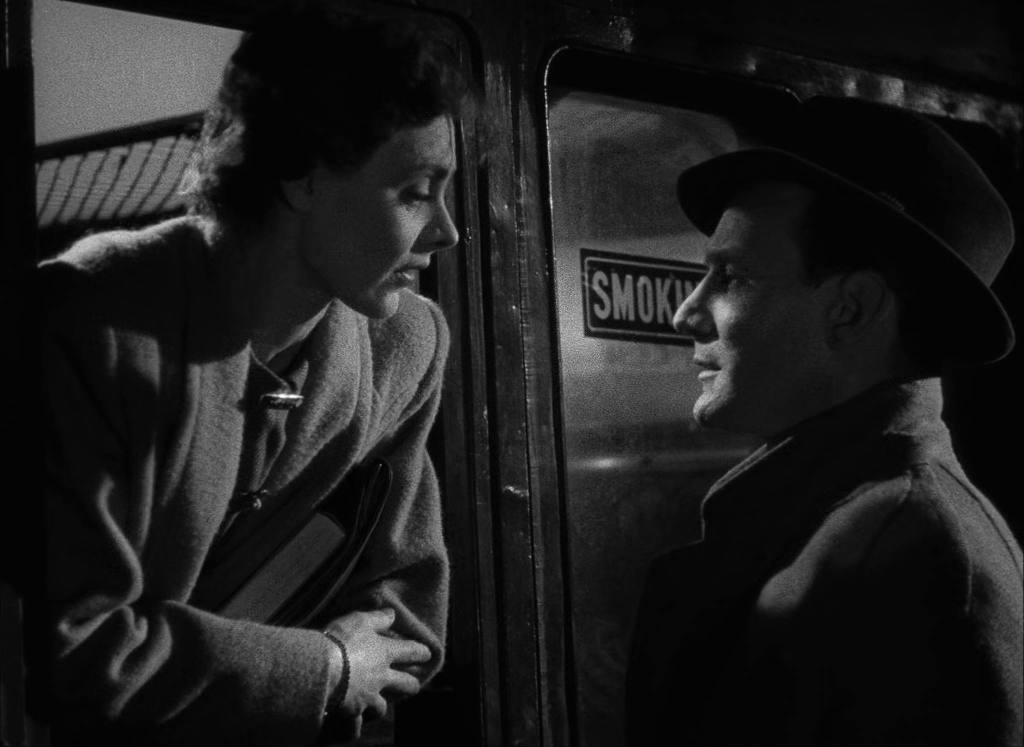
Also known as Begegnung
Great Britain 1945
Synopsis: Meeting a stranger in a railway station, a woman is tempted to cheat on her husband. – IMDb
Cineguild/Independent Producers; released through Eagle-Lion Distributors; produced by Noel Coward; Production: Anthony Havelock-Allan and Ronald Neame; based on the play Still Life by Noel Coward; written by Noel Coward, Anthony Havelock-Allan, David Lean and Ronald Neame.
Directed by David Lean.
Film type & format: Black and white, 1.37:1.
Director of Photography: Robert Krasker; Additional Photography: Ronald Neame; Operator: Bunny Francke; Focus Pullers: Jim Body, Arthur Ibbetson; Clapper Loaders: Alan Bryce, E. Owen; Music: Rachmaninoff; Musician: Eileen Joyce playing Rachmaninoff’s 2nd Piano Concerto, performed by the National Symphony Orchestra, conducted by Muir Mathieson; Editing: Jack Harris; Assistant Editor: Margery Saunders, John Cooke, Winston Ryder; Art Director: Lawrence P. Williams; Assistant Art Director: Elven Webb; Art Supervisor for Mr Coward: G.E. Calthrop; Draughtsmen: William Kellner, Herbert Westbrook, R. Field-Smith; Scenic Decorator: George Demaine; Back Projection: Charles Staffell; Production Manager: Ernest J. Holding; Location Manager: T. Tomson; 2nd Unit and Assistant Director: George Pollock; Assistant Director: Victor Wark, Chick Simpson; Sound: Desmond Dew, Stanley Lambourne; Dubbing: Peter T. Davies; Boom Operator: Eric Clennell; Sound Editor: Harry Miller; Special Effects: George Blackwell; Other Crew: Maggie Unsworth; Continuity: Renée Glynne
Cast: Celia Johnson, Trevor Howard, Stanley Holloway, Joyce Carey, Cyril Raymond, Everly Gregg, Marjorie Mars, Margaret Barton.
Duration: 86 minutes.
GB Release: 11 February 1946.
Dates & locations: Filmed from mid-January 1945 to mid-February 1945 at Carnforth Station, Lancashire, also at Middle Fell Bridge, Langdale Beck, Lake District, Long Bridge, Cumbria (little bridge scene), and from mid-February to the beginning of May 1945 at Denham Studios, Denham, exteriors in Beaconsfield, Buckinghamshire (Street Scenes: Burke’s Parade, Station Parade, Milford High Street), Regent’s Park, London (boating lake), Metropole Cinema, Victoria Street, London (interiors of Palladium Cinema), Swan Public House, Denham, Buckinghamshire, England.


Links
- IMDb – Brief Encounter
- Wikipedia – Brief Encounter
Great Expectations

Also known as Geheimnisvolle Erbschaft
Great Britain 1945
Synopsis: A humble orphan boy in 1810s Kent is given the opportunity to go to London and become a gentleman, with the help of an unknown benefactor. – IMDb
Directed by David Lean.
Film type & format: Black and white, 1.37:1.
Photographed by Guy Green (AA).
Note: Krasker was first hired as Director of Photography and filmed the beginning in St. Mary’s Marshes, Kent in summer 1945 and was then sacked by David Lean because of his “too soft” photography.
Comment: Imagine if David Lean had held his nerve and Robert Krasker had done the cinematography for the whole film and not just the opening scene.
In the British Film Institute’s British Cinematographers (1996) Professor Duncan Petrie of the University of York writes “His day-for-night sequences shot at dawn on Romney Marsh are still moments to savour. His assistant Alan Hume recalls that he used a red filter to bring out the maximum contrast in conjunction with graduated filters to keep the sky dark where necessary.”

Links
- IMDb – Great Expectations
- Wikipedia – Great Expectations
Odd Man Out
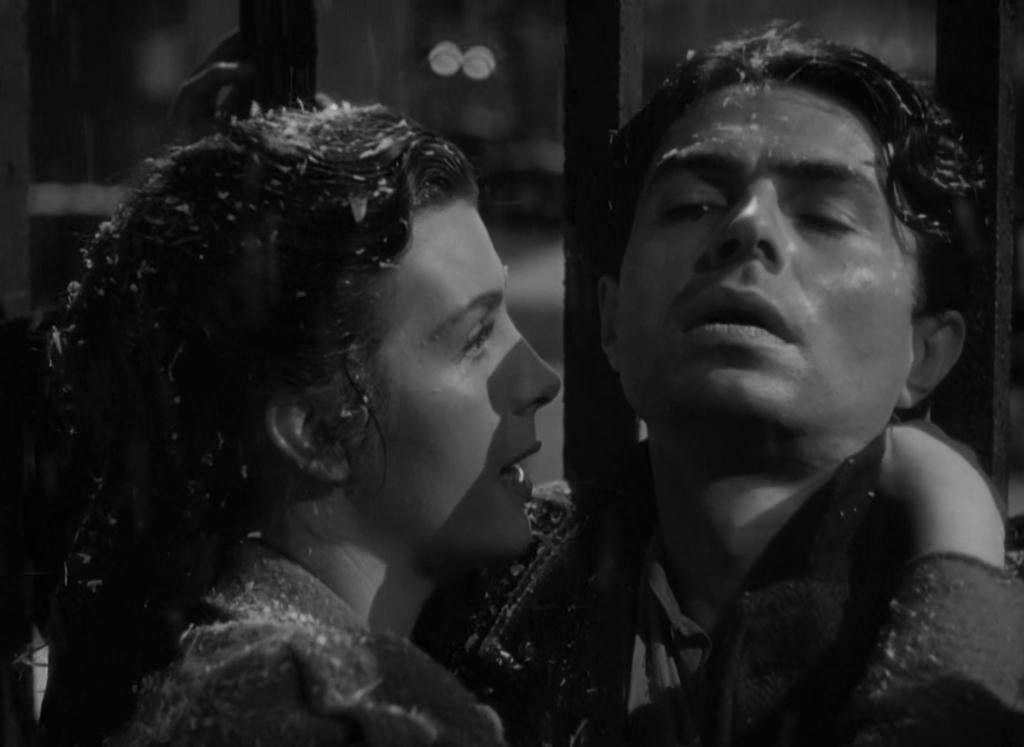
Also known as Ausgestossen and Huit heures de sursis
Great Britain 1945/46
Synopsis: A wounded Irish nationalist leader attempts to evade police following a failed robbery in Belfast. – IMDb
Two Cities Film; released by General Film Distributors; produced by Carol Reed, Phil C. Samuel, Herbert Smith; after the Novel by F.L. Green; written by F.L. Green and R.C. Sheriff.
Directed by Carol Reed.
Film type & format: Black and white, 1.37:1.
Director of Photography: Robert Krasker; 2nd Unit Camera: Stanley Grant; Camera Operators: Harold Arthur “Russell” Thomson, Laurie Friedman; Focus Puller: Gerry Massey-Collier; Clapper Loader: F. Goldsmith; Camera Assistant: Alan Cullimore; Electrician: Maurice Gillett; Stills: David Boulton; Music: William Alwyn; Music Director: Muir Mathieson; Orchestra Leader: George Stratton, played by the London Symphony Orchestra; Film Editor: Fergus McDonnell (AA): Assistant Editor: Geoffrey Muller; Casting: Irene Howard; Assistant: Maude Spector; Art Director: Ralph W. Brinton; Assistant Art Director: Betty Pierce; Production Decor: Roger K. Furse; Backings: E. Lindegaard; Scenic Artists: Alexander Bilibin, E. . Brister, Colleen Browning; Construction: Jim Tillyer, Stanely Yeomanson; Costumes: Peggy Henderson, Fred Pridmore, Harry Haynes; Makeup: N. Hutchinson, G. Mack, Tony Sforzini; Production Manager: Filippo del Giudice, Frank Bevis; 2nd Unit and Assistant Director: Mark Evans, Anthony Hearne; Carol Reed’s Personal Assistant: Mrs M. Pratt; Sound: Desmond Dew, Amy Fisher, Harry Miller, John W. Mitchell; Dubbing: Peter T. Davies; Sound Editor: Harry Miller; Special Effects: Stanley Grant, Bill Warrington; Continuity: Olga Brooks; Cecil F. Ford; Irish advisors: Joseph Tomelty; Stand-In for Mr Mason: George Leech.
Cast: James Mason, Robert Newton, Cyril Cusack, Kathleen Ryan, F.J. McCormick, William Hartnell, Fay Compton, Denis O’Dea, W.G. Fay, Maureen Delaney, Elwyn Brook-Jones, Robert Beatty, Dan O’Herlihy, Kitty Kirwan, Beryl Measor, Roy Irving, Joseph Tomelty, Arthur Hambling, Ann Clery, Maura Milligan, Maureen Cusack, Eddie Byrne, Min Milligan, Noel Purcell, Guy Rolfe, Dora Bryan, Geoffrey Keen.
Duration: 115 minutes.
GB Release: 17 May 1947.
Dates & locations: Filmed from September 1945 to January 1946 at Denham Studios, Buckinghamshire, and in Broadway Market, Hackney, London and in February 1946 in Belfast (Crown Bar Interiors).

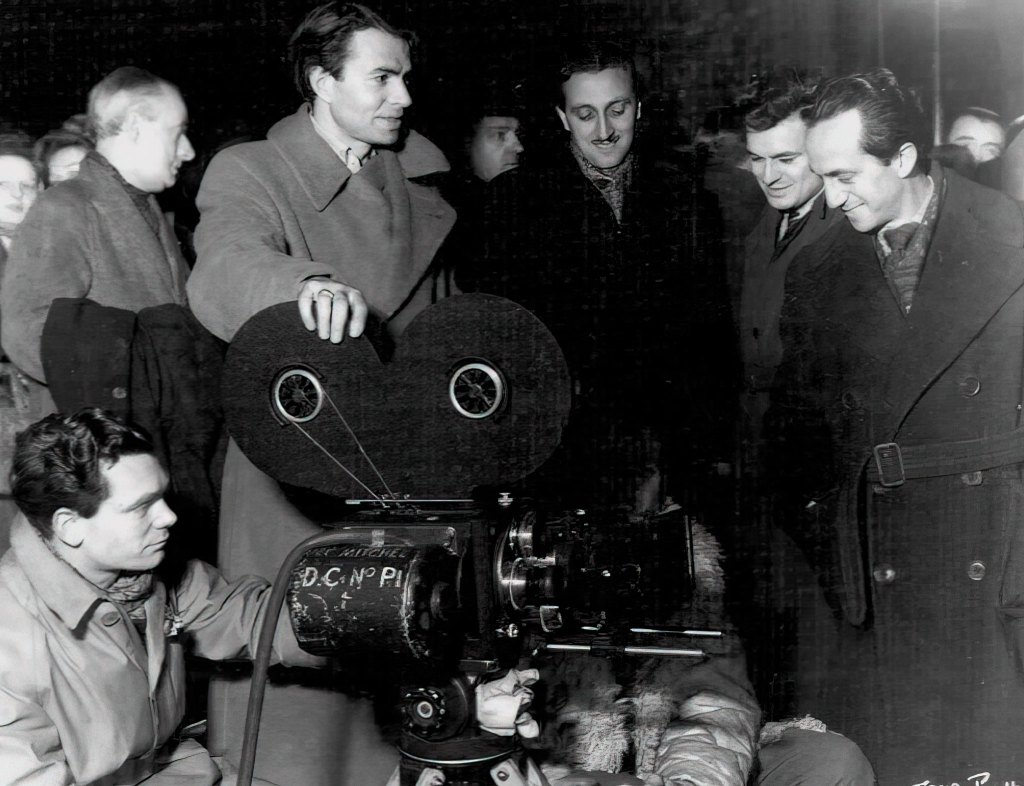
Links
- IMDb – Odd Man Out
- Wikipedia – Odd Man Out
Uncle Silas

Also known as The Inheritance
Great Britain 1946
Synopsis: Following her father’s death, a British teen-aged heiress goes to live with her guardian uncle who is broke, and he schemes to murder her for her vast inheritance. – IMDb
Two Cities Film Productions; released through General Film Distributors; produced by Laurence Irving, Josef Somlo; Associate Producer: Jack Hicks; after the Novel by Sheridan Le Fanu; written by Ben Travers.
Directed by Charles Frank.
Film type & format: Black and white, 1.37:1.
Director of Photography: Robert Krasker; Camera Operators: Robert Huke, Ray Sturgess, Sidney Davies; Focus Puller: Buddy Minchin Clapper Loader: F. Goldsmith; Music: Alan Rawsthorne, played by the London Symphony Orchestra, directed by: Muir Mathieson; Film Editor: Ralph Kemplen; Assistant Editors: Patricia Murry,Peter Taylor, Roy Fry; Casting: Irene Howard; Crowd Casting: Gerry Dereham; Art Director: Laurence Irving; Assistant Art director: Ralph W. Brinton, Kenneth McCallum; Set Dresser: Colleen Browning; Draughtsmen: Ted Marshall, Marcel Diserens, Eric Blakemore, Anthony Hale, Syd Cain, Peter Phillips; Script Illustrator: Maurice Laban; Buyer: Sid Siddall; Costumes: Elizabeth Haffenden; Costumes Assistant: Doris Lee; Wardrobe Master: Fred Pridmore; Makeup: Tony Sforzini; Floor Make-Up: H. Hutchinson; Production Management: John W. Gossage, Andrew Allan, Peter Berg; Production Executive: Herbert Smith; 2nd Unit and Assistant Director: Peter Bolton, Tony Hearne, Stanley Hosgood; Location Managers: Viktor Wark, Len Lee; Sound: John Cook; Dubbing: Desmond Dew; Dubbing Crew: L.E. Overton, George Willows, D. Taylor, Anthony J. Kay, Peter T. Davies; Sound Editor: Kenneth Heeley-Ray; Sound Recordist: Alfred Miller; Sound Mixer: F. Minter; Sound Engineers: Walter R. Day, D. Taylor; Boom Operators: Fred Ryan, Ken Ritchie, John Streeter; Painted Mattes: Bill Warrington, Joan Suttie, Sheila Wilson; Special Effects: Henry Harris, George Blackwell, Stanley Grant, Percy Ralphs; Stills: George Cannon; Continuity: Joan Barry, Olga Brooks.
Cast: Jean Simmons, Katina Paxinou, Derrick de Marney, Derek Bond, Sophie Stewart, Esmond Knight, Reginald Tate, Manning Whiley, Marjorie Rhodes, John Laurie, Frederik Burtwell, George Curzon, O.B. Clarence, Frederick Ranalow, Patricia Glyn, Guy Rolfe, Robin Netscher, John Salew, Patricia Dainton, Reginald Tate.
Duration: 103 minutes.
GB Release: 8 October 1947, London.
Dates & locations: Filmed in summer and autumn 1946 at Denham Studios, Buckinghamshire, England. Krasker’s last film in Denham.

Links
- IMDb – The Inheritance
- Wikipedia – Uncle Silas
Bonnie Prince Charlie
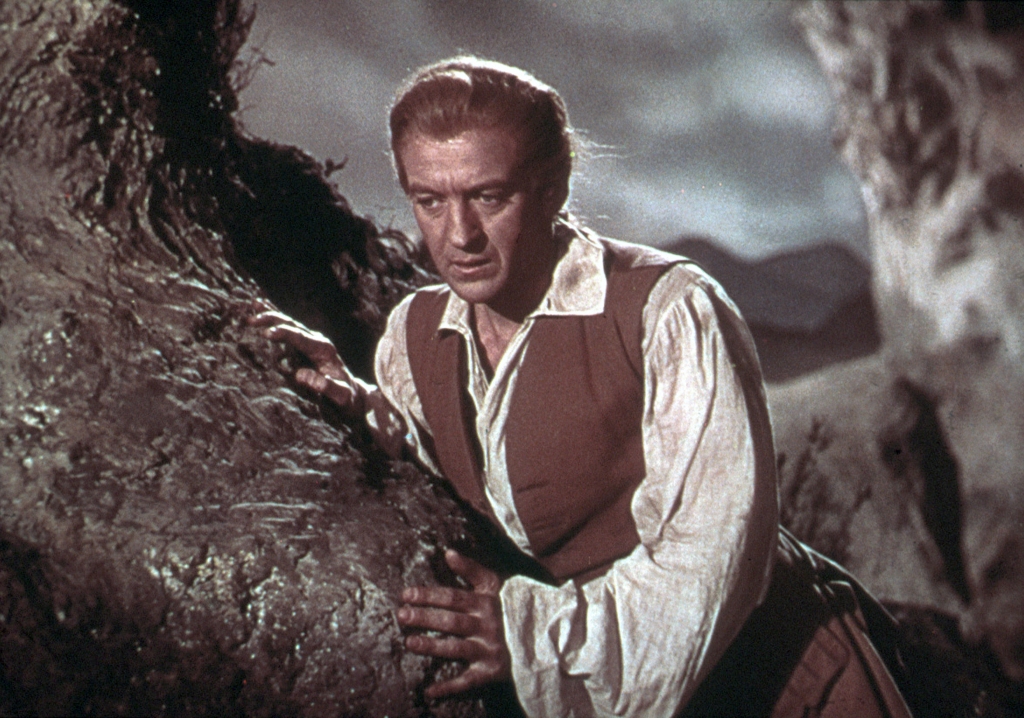
Great Britain 1947
Synopsis: In the Jacobite Rising of 1745, the Young Pretender Bonnie Prince Charlie leads an insurrection to overthrow the Protestant House of Hanover and restore his family, the Catholic branch of the House of Stuart, to the British throne. – IMDb
London Film Productions; released through British Lion Film Corporation; produced by Edward Black; written by Clemence Dane.
Directed by Anthony Kimmins and Alexander Korda (uncredited).
Film type & format: Technicolor, 1.37:1.
Director of Photography: Robert Krasker; Camera Operator: Edward Scaife; Associate Photographer: Hone Glendinning; Exterior Photography: Osmond Borradaile; Music: Ian Whyte; Music Director: Hubert Clifford, played by the London Film Symphony Orchestra; Film Editor: Grace Garland; Art Director: Vincent Korda, Wilfred Shingleton, Josef Bato, Bill Beavis; Scenic Painting: W. Simpson Robinson; Production Manager: Jack Swinburne; Costumes: George K. Benda; Makeup: U. P. Hutchinson, Joe Shear; 2nd Unit and Assistant Director: Bluey Hill, Laurie Knight; Sound: John Cox, A.G. Ambler, Red Law; Sound Editor: Ben Hipkins; Visual Effects: W. Percy Day, Judy Jordan; Special Effects: Cliff Richardson; Stunts: Robert Porter, Nosher Powell; Continuity: Winifred Dyer, Angela Allen; Historical Adviser: Cyril Hartman, A.E. Haswell-Miller; Colour Consultant: Natalie Kalmus, Joan Bridge.
Cast: David Niven, Margaret Leighton, Judy Campbell, Jack Hawkins, Morland Graham, Finlay Currie, Elwyn Brook-Jones, John Laurie, Hector Ross, Hugh Kelly, Charles Goldner, Henry Oscar, Guy Le Feuvre, Franklin Dyall, Herbert Lomas, Ronald Adam, Stuart Linsell, John Longden, James Hayter, Torin Thatcher, Simon Lack, Tommy Duggan, Martin Miller, G.H. Mullcaster, Charles Goldner, Julian Mitchell, Hugh Kelly, Ken Warrington, Nell Ballantyne, Patricia Fox, Molly Rankin, John Rae, Lola Duncan, John Forrest, Jean Stuart, Jane Gill-Davis, Louise Gainsborough, Edward Lexy.
Duration: 118 minutes.
GB Release: 26 October 1948, London; US Release: 29 January 1952.
Dates & locations: Filmed at Eilean Donan Castle, Kyle of Lochalsh (Highlands), Glen Coe (Highlands), Glenfinnan (Highlands), The Old Man of Storr, Skye (Highlands) and Shepperton Studios, Surrey, from summer 1947 for thirty weeks until February 1948. Krasker’s first film at Shepperton Studios.
Links
- IMDb – Bonnie Prince Charlie
- StudioCanal – Bonnie Prince Charlie
- Wikipedia – Bonnie Prince Charlie
The Third Man

Also known as Der dritte Man
Great Britain 1948–49
Synopsis: Pulp novelist Holly Martins travels to shadowy, postwar Vienna, only to find himself investigating the mysterious death of an old friend, Harry Lime. – IMDb
London Film Productions; released through British Lion Distributors; produced by Carol Reed, Alexander Korda, David O. Selznick; Associate Producer: Hugh Perceval; after a story by Graham Greene; written by Graham Greene.
Directed by Carol Reed.
Film type & format: Black and white, 1.37:1.
Director of Photography: Robert Krasker (AA); Additional Photography: John Wilcox (day unit in Vienna), Stan Pavey (sewer unit in Vienna), Hans Schneeberger (Vienna); Camera Operators: Edward Scaife, Denys Coop; Camera Loader: J. Bicknell; Clapper Loader: Alan McCabe; Focus Puller: Geoff Meldrum; Camera Loader: Joe Vincent; Electricians: H. Machay, Bert Whitear, S. Dye, Archie Dansie; Stills: Len Lee Music: Anton Karas; Editor: Oswald Hafenrichter; Assembly Cutter: Peter Taylor; Assistant Editor: Derek Armstrong; Assistant Cutters: Ken Behrens, David Eady; Extra Assistant Cutter: Michael Coton; Set Director: Vincent Korda; Assistants: Joseph Bato, John Hawkesworth; Set Dresser: Dario Simoni; Assistant Art Directors: Ferdinand Bellan, James Sawyer; Production Buyer: George Durant; Floor Props: Sydney Leggett, Bobby Murell, J. Larkin, F. Dann; Standby Carpenter: W. Nichols; Standby Painter: P. Tindle; Standby Plasterer: E. Greenleaf; Standby Rigger: J. Culley; Stagehands: A. Southall, H. Turner; Makeup: George Frost; Assistant: Peter Evans; Hair Dressing: Joe Shear, Iris Tilley; Production Management: T.S. Lyndon-Haynes; Production Secretary: Teresa Deans; Assistant Director: Guy Hamilton; Assistant Director Vienna: Gino Wimmer; 2nd Assistant Director: Jack Causey; 3rd Assistant Director: Jack N. Green; Sound: John Cox; Sound Editor: Jack Drake; Assistant Sound Editor: John Glen; Sound Recordists: Red Law, Bert Ross; Boom Operator: Jack Davies; Sound Camera Operator: James Dooley; Sound Maintenance: Dick Longstaff; Visual Effects: W. Percy Day; Costumes: Ivy Baker, Gene Hornsby, George Murray, Dickie Richardson; Presenter US-Version: Joseph Cotten; Continuity: Peggy McClafferty; Advisor Austria: Elizabeth Montagu; Script Supervisor: Angela Allen; Unit Publicist: Enid Jones; B-Unit: Assistant Director: George Pollock; Accountant: R. Reader; Production Assistant: Robert Dunbar; Camera Operator: Monty Berman; Focus Puller: John van Kotze; Sound Recordist: George Adams; Sound Operator: P. Jackson.
Cast: Joseph Cotten, Alida Valli, Orson Welles, Trevor Howard, Bernard Lee, Paul Hörbiger, Ernst Deutsch, Siegfried Breuer, Erich Ponto, Wilfrid Hyde-White, Hedwig Bleibtreu, Eric Pohlmann, Reed de Rouen, Paul Hardtmuth, Annie Rosar, Herbert Halbik, Jenny Werner, Alexis Chesnakov, Frederick Schrecker, Thomas Gallagher, Martin Boddey, Geoffrey Keen, Lilly Kahn, Leo Bieber, Nelly Arno, Anthony Higgins, Geoffrey Wade, Walter Hertner, Martin Miller.
Duration: 104 minutes.
GB Release: 2 September 1949 Plaza Theatre, London; US Release: 4 February 1950 Victoria Theatre, New York.
Dates & locations: Filmed from 22.10.1948 to 11.12.1948 in Vienna –Josephsplatz 5 (Harry Lime’s apartment), Morzinplatz (Kurtz’s Haus), Neuer Markt (“Café Mozart”), Prater, Reichsbrücke, Zentralfriedhof, from January 1949 to March 1949 at London Film Studios, Shepperton, Surrey, and Worton Hall Studios.
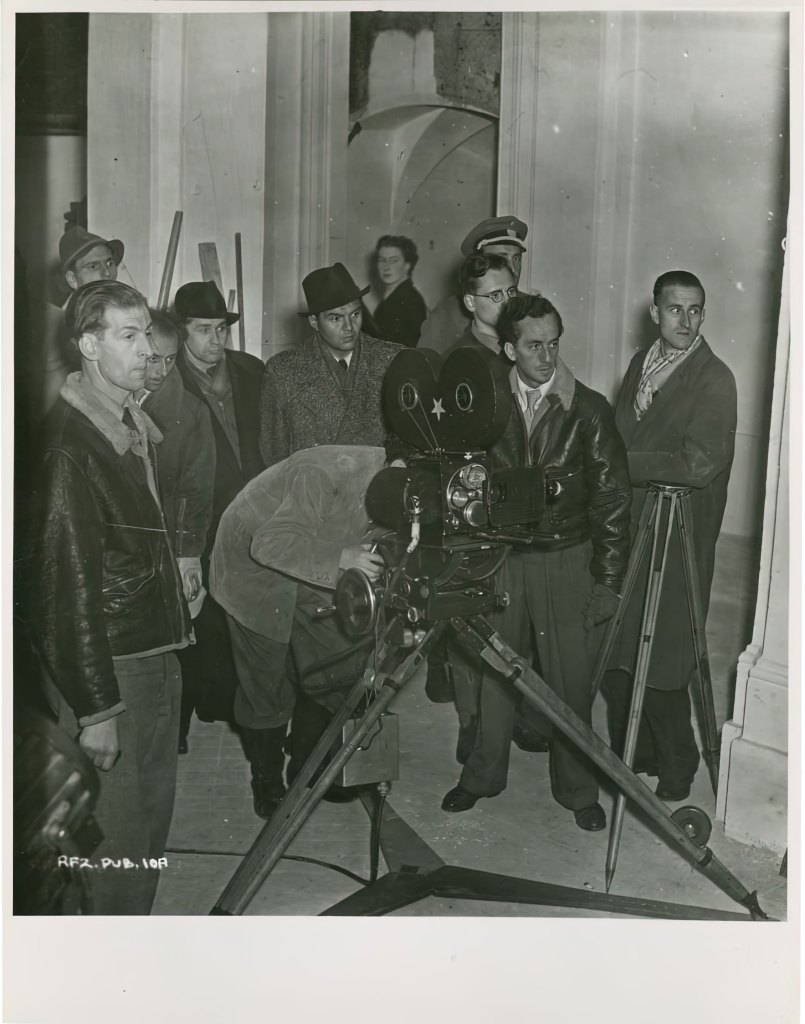
Links
- IMDb – The Third Man
- Wikipedia – The Third Man
The Angel with the Trumpet
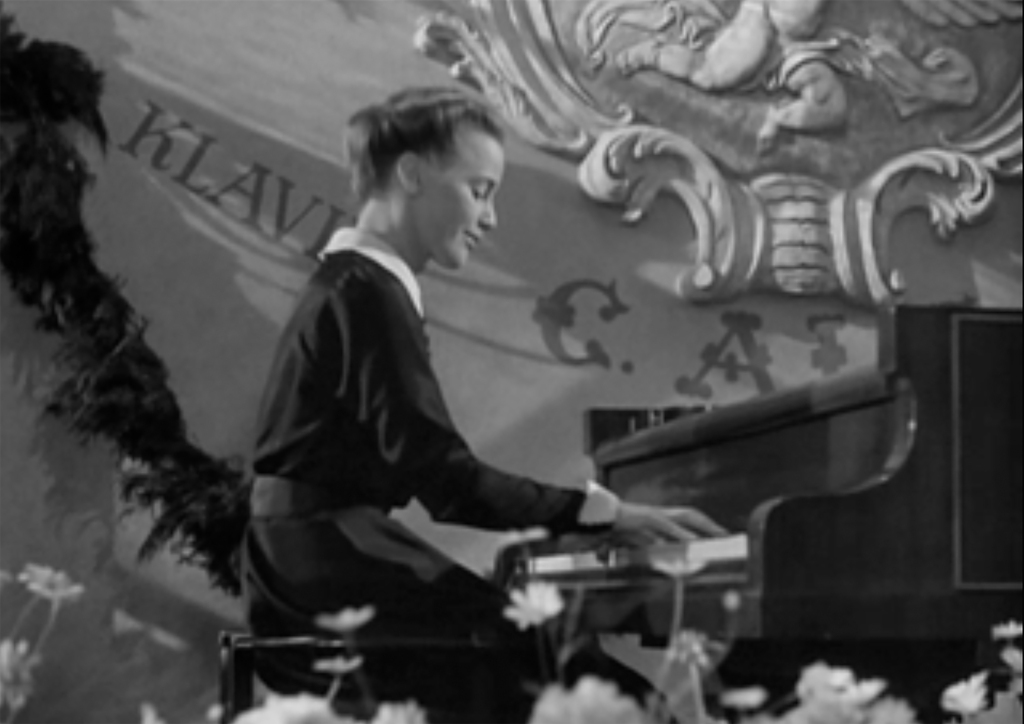
Also known as Angel with a Trumpet
Great Britain 1949
Synopsis: In the nineteenth century, a young Austrian woman marries into a wealthy family and witnesses the country change through the course of four decades. – IMDb
London Film Productions; released through British Lion Distributors; produced by Karl Hartl; after the novel Der Engel mit der Posaune by Ernst Lothar; written by Clemence Dane, Karl Hartl, Franz Tassié (Remake of Der Engel mit der Posaune, Austria 1948).
Directed by Karl Hartl (alias Anthony Bushell).
Film type & format: Black and white, 1.37:1.
Director of Photography: Robert Krasker, BSC; Camera Operator: Denys Coop; Focus Puller: Peter Broxup; Music: Willy Schmidt-Gentner; Editor: Reginald Beck, Ron Simpson; Casting: Dorothy Holloway; Costumes: Roger K. Furse, Ivy Baker, Julia Squire, Evelyn Gibbs, Kack Dalmagne, Dickie Richardson; Makeup: Peter Evans, Dorrie Hamilton; Hair: Iris Tilley, Barry Elman; Production Manager: Jack Swinburne; 2nd Unit and Assistant Director: Guy Hamilton, Jack Causey; Art Director: André Andrejew, Ferdinand Bellan, Dario Simoni, James Sawyer; Sound: John Cox, Red Law, Bert Ross, Jack Davies, Sandy Fairlie, Allan Play; Continuity: Maisie Kelly; Dialogue Director: Elizabeth Montagu; Production Secretary: Joan Williams; Stills: Len Lee; Commentator: Jack Hawkins.
Cast: Eileen Herlie, Basil Sydney, Norman Wooland, Maria Schell, Olga Edwardes, Andrew Cruikshank, John Justin, Oskar Werner, Wilfrid Hyde-White, Anthony Bushell, Anton Edthofer, Jill Gibbs, Campbell Cotts, Dorothy Batley, John van Eyssen, Jane Henderson, Olga Edwardes, Alan Woolstan, Alfred Neugebauer, Joan Schofield, Meadows White, Jack Faint, Davia Davies, Olive Gregg.
Duration: 98 minutes.
GB Release: 20 March 1950; US Release: 1952.
Dates & locations: Filmed from April 4, 1949 to June 24, 1949 at Shepperton Studios, Surrey, England.
Links
- IMDb – The Angel with the Trumpet
- StudioCanal – The Angel with the Trumpet
- Wikipedia – The Angel with the Trumpet
State Secret

Also known as The Great Manhunt, Staatsgeheimnis
Great Britain 1949
Synopsis: In post-WW2 Europe, when the dictator of a small police state dies during surgery, the operating surgeon, who is a visiting American doctor, is held captive in order to preserve the terrible state secret. – IMDb
London Film Productions; released through British Lion Distributors; produced by Sidney Gilliat and Frank Launder; after the novel Appointment with Fear by Roy Huggins; written by Roy Huggins and Sidney Gilliat.
Directed by Sidney Gilliat.
Film type & format: Black and white, 1.37:1.
Director of Photography: Robert Krasker, BSC; Additional Photography: John Wilcox; Camera Operator: Edward Scaife; Assistant Camera: Gerry Fisher; Assistant: John Harris (uncredited); Music: William Alwyn, played by the Royal Philharmonic Orchestra; Music Director: Muir Mathieson; Film Editor: Thelma Myers-Connell, Derek Armstrong; Art Director: Wilfred Shingleton, John Hawkesworth, Kenneth McCallum; Costumes: Ivy Baker, Beatrice Dawson; Makeup: Michael Morris; Hair Dresser: Waleen Whitworth; Production Manager: Leslie Gilliat; Assistant: Cyril Coke; 2nd Unit and Assistant Director: Guy Hamilton; Sound: Alan Allen, Lee Doig, Ernest Webb; Continuity: Paddy Arnold; Assistant Producer: Cyril Coke; Language Advisor: Georgina Shield.
Cast: Douglas Fairbanks Jr., Jack Hawkins, Glynis Johns, Walter Rilla, Karel Stepanek, Herbert Lom, Hans Olaf Moser, Guido Lorraine, Robert Ayres, Howard Douglas, Martin Boddey, Carl Jaffe, Eric Pohlmann, Olga Lowe, Therese van Kye, Leonard Sachs, Russell Waters, Arthur Howard, Carl Jaffé, Gerard Heinz, Leslie Linder, Leo Bieber, Nelly Arno, Paul Demel, Danny Green, Anton Diffring, Peter Illing, Arthur Reynolds, Guido Lorraine, Alexis Chesnakov.
Duration: 104 minutes.
GB Release: 11 September 1950; US Release: December 1950.
Dates & locations: Filmed in Dolomites, Fai della Paganella, 6000 feet, July-August 1949, Italy, Trento, and to mid-October 1949 in Shepperton Studios, Surrey, England.
Note: Has been broadcast in Australia under the incorrect name State Street.
Links
- IMDb – The Great Manhunt
- Wikipedia – State Secret
The Wonder Kid

Also known as Wonder Boy, Entführung ins Glück
Great Britain/Austria 1950
Synopsis: A child pianist is exploited by his manager who plans to adopt him. His governess helps him to get away, where he befriends some colourful characters and acquires a faithful pet dog. – IMDb
London Film Productions; produced by Karl Hartl; released through British Lion Distributors, after an original story by Karl Hartl; written by Gene Markey.
Directed by Karl Hartl.
Film type & format: Black and white, 1.37:1.
Director of Photography: Robert Krasker, BSC; Camera Operator: Denys Coop; Co-Photography: Günther Anders; Music: Willy Schmidt-Gentner, Hubert Clifford; Film Editor: Reginald Beck; Art Director: Joseph Bato, Werner Schlichting; Production Manager: Ronald Kinnoch; Assistant Director: Jack Causey; Dialogue Director: Elizabeth Montagu.
Cast: Bobby Henrey, Elwyn Brook-Jones, Muriel Aked, Oskar Werner, Robert Shackleton, Christa Winter, Sebastian Cabot, Klaus Birsch, Paul Hardtmuth, June Elvin.
Duration: 85 minutes.
GB Release: 18 November 1951; German Release: 12 January 1951.
Dates & locations: Exteriors filmed in the Alps, studio at Shepperton Studios, London, German-speaking version shot in Austria.
Links
- IMDb – Wonder Boy
- Wikipedia – The Wonder Kid
Cry, the Beloved Country

Also known as Denn sie sollen getröstet werden
Great Britain 1950
Synopsis: In the back country of South Africa, black minister Stephen Kumalo journeys to the city to search for his missing son, only to find his people living in squalor and his son a criminal. Reverend Misimangu is a young South African clergyman who helps find his missing son-turned-thief and sister-turned-prostitute in the slums of Johannesburg. – IMDb
London Film Productions; released through British Lion Distributors; produced by Zoltan Korda and Alan Paton; written after his novel by Alan Paton and John Howard Lawson.
Directed by Zoltan Korda.
Film type & format: Black and white, 1.37:1.
Director of Photography: Robert Krasker, BSC; Camera Operator: Gerry Massy-Collier; Assistant: John Harris (uncredited); Assistant Interiors: Gerry Fisher; 2nd unit: Peter Lang, David Millen; Music: Raymond Gallois-Montbrun, Hubert Clifford, played by the London Film Symphony Orchestra; Film Editor: David Eady, Valerie Leslie; Art Director: Wilfred Shingleton; Makeup: Peter Evans; Production Manager: Jack Swinburne; 2nd Unit and Assistant Directors: John Bremer, Guy Hamilton; Sound: Red Law, John W. Mitchell; Dubbing: Lee Doig, Jack Drake, Max Elliott; Continuity: Maisie Kelly; Advisor Africa: Frank Rogaly.
Cast: Canada Lee, Charles Carson, Sidney Poitier, Joyce Carey, Geoffrey Keen, Michael Goodliffe, Edric Connor, Charles McRae, Lionel Ngakane, Vivien Clinton, Albertina Temba , Ribbon Dhlamini, Edward Forsyth, Bruce Meredith Smith, Bruce Anderson, Berdine Grunewald, Cecil Cartwright, Andrew Kay, Shayiwa Riba, Tsepo Gugushe, Daniel Adnemah, Emily Pooe, Reginald Ngcobo, Michael Golden, Clement McCallin, Stanley van Beers, John Arnatt, Scott Harrold, Ellen Kuzwayo.
Duration: 103 minutes.
GB Release: 25 April 1952; Premiered in South Africa simultaneously in Durban, Cape Town and Johannesburg; US Release: 23 January 1952, New York.
Dates & locations: Filmed from August 3, 1950 for seven weeks in Ixopo (near Pietermaritzburg) and five weeks in Johannesburg, South Africa and Shepperton Studios, Surrey until November 1950, with retakes in May 1951 and in July 1951.
Links
- IMDb – Cry, the Beloved Country
- Wikipedia – Cry, the Beloved Country
Another Man’s Poison

Also known as Gift für einen anderen
Great Britain 1951
Synopsis: A mystery writer becomes involved in a tangled web of murderous deception not unlike the plots of her novels. – IMDb
Douglas Fairbanks Productions for Daniel Angel Films; released through Eros Films; produced by Daniel M. Angel and Douglas Fairbanks Jr. after his play Deadlock; written by Leslie Sands and Val Guest.
Directed by Irving Rapper.
Film type & format: Black and white, 1.37:1.
Director of Photography: Robert Krasker, BSC; Camera Operator: John Harris; Stills: Cyril Stanborough; Music: John Greenwood, Paul Sawtell, Philip Martell; Film Editor: Gordon Hales; Art Director: Cedric Dawe; Costumes: Julie Harris; Makeup: Nina Broe, Freddie Williamson; Production Manager: Adrian D. Worker; Assistant Director: George Fowler; Sound: H. C. Pearson; Continuity: Shirley Barnes.
Cast: Bette Davis, Gary Merrill, Emlyn Williams, Anthony Steel, Barbara Murray, Reginald Beckwith, Edna Morris.
Duration: 89 minutes.
GB Release: 20 November 1951, London.
Dates & locations: Filmed from March 1951 for eight weeks at Nettlefold Studios, Walton-on-Thames, exteriors at Malham Tam House and Malham, North Yorkshire, England.
Links
- IMDb – Another Man’s Poison
- Wikipedia – Another Man’s Poison
Never Let Me Go

Also known as Es begann in Moskau
Great Britain 1952
Synopsis: An American reporter stationed in post-war Moscow marries a ballet dancer, but their relationship is threatened by the country’s political volatility. – IMDb
Metro-Goldwyn-Mayer British Studios; released through MGM/United Artists; produced by Clarence Brown; after the Novel by Roger Bax Came the Dawn; written by Ronald Millar and George Froeschel.
Directed by Delmer Daves.
Film type & format: Black and white, 1.37:1.
Director of Photography: Robert Krasker, BSC; Camera Operator: Skeets Kelly; Music: Hans May; Film Editor: Frank Clarke; Art Director: Alfred Junge; Sound: A.W. Watkins; Visual Effects: Tom Howard; Dance Partner of Gene Tierney: Anton Dolin; Ballet Teacher: Felicy Gray.
Cast: Clark Gable, Gene Tierney, Bernard Miles, Richard Haydn, Belita, Kenneth More, Karel Stepanek, Theodore Bikel, Anna Valentina, Frederik Valk, Peter Illing, Robert Henderson, Stanley Maxted, Meinhart Maur, Alexis Chesnakov, Anton Diffring.
Duration: 94 minutes.
GB Release: 18 March 1953, London.
Dates & locations: Filmed from June to September 1952 at MGM Borehamwood Studios, Hertfordshire, exteriors in Megavissey, Mullion Cove and Newquay, Cornwall, with shooting being delayed by bad weather.
Links
- IMDb – Never Let Me Go
- Wikipedia – Never Let Me Go
Malta Story
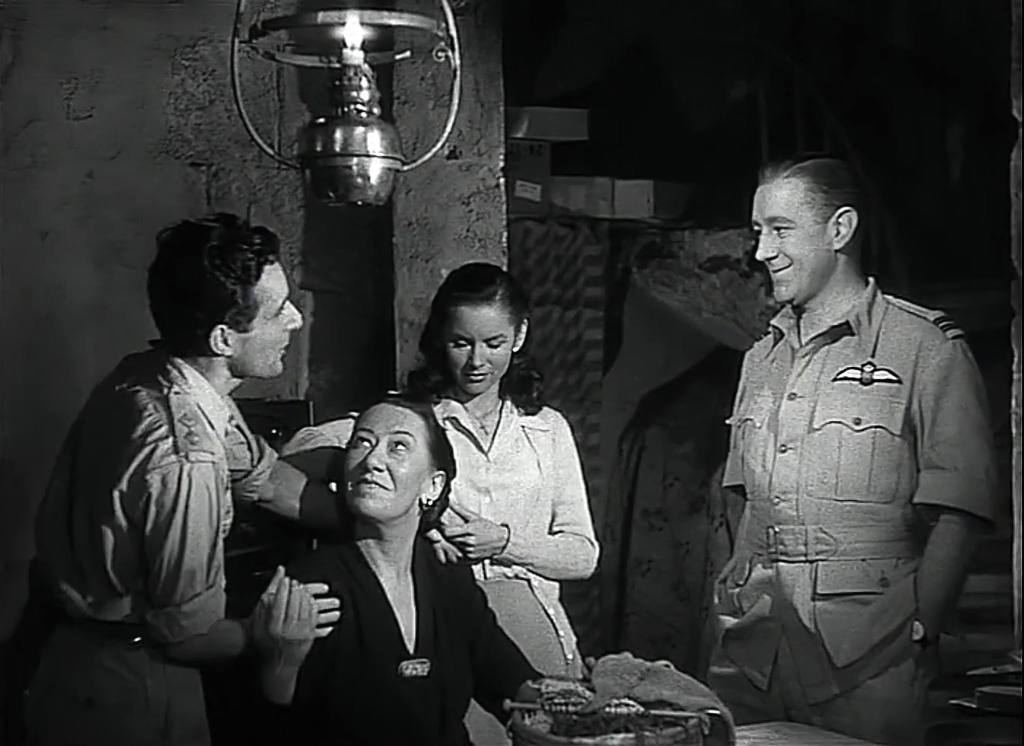
Great Britain 1952
Synopsis: 1942 and the island of Malta is battling for survival. The threat of invasion by Axis forces is increasing as air raids wear down its defence. Entering this maelstrom is Flight Lieutenant Peter Ross, an RAF photo-reconnaissance pilot. – IMDb
British Film Makers, Ealing Studios, Theta Film Production; released through General Film Distributors; produced by Peter De Sarigny and Earl St. John; after the book by Hugh P. Lloyd Briefed to Attack; written by Nigel Balchin, Peter de Sarigny, Thorold Dickinson and William Fairchild.
Directed by Brian Desmond Hurst.
Film type & format: Black and white, 1.37:1.
Director of Photography: Robert Krasker, BSC; Camera Operator: H.A.R. Thomson; Clapper Loader: John Morgan; Focus Puller: Reginald H. Morris; Camera Operator 2nd Unit: Ernest Steward; Music: William Alwyn; Music Director: Muir Mathieson; Film Editing and 2nd Unit Director: Michael Gordon; Editing Assistant: Derek Armstrong; Casting: Weston Drury; Art Director: John Howell, John Box, Robert Cartwright, Bert Gaiters, Dario Simoni; Makeup: W. . Partleton, Biddy Chrystal; Production Manager: Hugh Attwooll; Assistant Director: George Pollock; 2nd Assistant director: Pat Marsden; 3rd Assistant Directors: Bert Batt, Maurice Gibson(last three uncredited); Sound: Gordon McCallum, John Mitchell, Eric Wood, Noreen Ackland, Bill Daniels, Basil Fenton-Smith, Willows George, Fred Hughesdon (last five uncredited); Special Effects: Bill Warrington, Albert Whitlock; Visual Effects: Bert Marshall; Costumes: Dorothy Edwards, Bob Rayner; Production Contributor Pinewood: Arthur Alcott; Continuity: Tilly Day; Production Secret: Teresa Bolland; Publicity Manager: Ken Green.
Cast: Alec Guinness, Jack Hawkins, Anthony Steel, Muriel Pavlow, Renée Asherson, Hugh Burden, Nigel Stock, Reginald Tate, Ralph Truman, Flora Robson, Ronald Adam, Derek Aylward, Michael Medwin, Noel Willman, Jerry Desmonde, Stuart Burge, Rosalie Crutchley, Victor Maddern, Sam Kydd, Maurice Denham, Gordon Jackson, Geoffrey Keen, Harold Siddons, Colin Loudon, Edward Chaffers, Ivor Barnard, Peter Bull.
Durations: 103 minutes.
First Night: 23 June 1953, London.
Dates & locations: Filmed on Malta and at Pinewood Studios, Buckinghamshire, England. Krasker’s first film at Pinewood.

Links
- IMDb – Malta Story
- Wikipedia – Malta Story
Romeo and Juliet

Also known as Giulietta e Romeo, and Romeo und Julia
Great Britain/Italy 1953
Synopsis: In Shakespeare’s classic play, the Montagues and Capulets, two families of Renaissance Italy, have hated each other for years, but the son of one family and the daughter of the other fall desperately in love and secretly marry. – IMDb
Rank Organisation/Universalcine; released through United Artists; produced by Sandro Ghenzi, Joseph Janni; Executive Producer: Earl St. John, Adapted after Shakespeare’s play by Renato Castellani.
Directed by Renato Castellani.
Film type & format: Technicolor, 1.37:1.
Director of Photography: Robert Krasker, BSC; Camera Operators: John Harris, Francesco Izzarelli; Music: Roman Vlad, Lambert Williamson; Film Editor: Sidney Hayers, Jolanda Benvenuti; Costumes: Leonor Fini, Giorgio Venzi; Makeup: Ernest Gasser, Ida Mills, Virgilio Morosetti, Vasco Reggiani; Production Manager: Armando Franci, Jack Hanbury; Assistant Director: Fraser Foulsham, Lu Leone; Sound: John Dennis, Gordon McCallum, Harry Miller, Winston Ryder; Production Assistant: Marino Alberti, Amilcare Fabrizio, Angelo Besozzi; Technicolor Consultant: Joan Bridge; Choreography: Madi Obolensky; Architectural Constructor: Gastone Simonetti; Continuity: Hazel Swift.
Cast: Laurence Harvey, Susan Shentall, Flora Robson, Norman Wooland, Mervyn Jones, John Gielgud, Bill Travers, Sebastian Cabot, Lydia Sherwood, Ubaldo Zollo, Enzo Fiermonte.
Duration: 135 minutes.
GB Release: 24 September 1954, London.
Dates & locations: Filmed from mid-April 1953 for three weeks in Rome, then six weeks north of Venice and ten weeks in Verona, three weeks in Siena and again two weeks in Rome to mid-October 53, a total of six months in Italy.
Links
- IMDb – Romeo and Juliet
- Wikipedia – Romeo and Juliet
Senso

Also known as Sehnsucht
Italy 1953
Synopsis: An Italian Countess is allied with Nationalists during the Italian-Austrian war of unification. However, she risks betraying their cause when she falls in love with an Austrian lieutenant. – IMDb
Lux Film; released through Lux Films; produced by Claudio Forges-Davanzali; after the Novel by Camillo Boito; written by Luchino Visconti, Suso Cecchi d’Amico, Carlo Alianello, Giorgio Bassani, Giorgio Prosperi; Dialogues by Tennessee Williams and Paul Bowles.
Directed by Luchino Visconti.
Film type & format: Technicolor, 1.37:1.
Directors of Photography: Aldo Graziati (G.R. Aldo) and Robert Krasker (when Graziati died during shooting on 14.11.1953 Krasker took over); Camera Operators: Giuseppe Rotunno (who finished the film), Michele Cristiani, Francesco Izzarelli; Film Editor: Mario Serandrei; Art Director: Ottavio Scotti, Gino Brosio; Costumes: Marcel Escoffier, Piero Tosi; Makeup: Alberto de Rossi; Production Manager: Domenico Forges Davanzati, Marcello Giannini, Gabriele Silvestri; Assistant Directors: Francesco Rosi, Aldo Trionfo, Giancarlo Zagni, Franco Zeffirelli, Jean-Pierre Mocky; Sound: Aldo Calpini, Vittorio Trentino; Executive Producers: Marcello Giannini, Gabriele Silvestri; Assistant: Gina Guglielmotti; Technicolor Technicians: Neil Binney, John Craig; Secretaries: Mary Alcaide, Gina Guglielmotti, Roberto Palaggi; Supervisor French Version: Jean Renoir.
Cast: Alida Valli, Farley Granger, Heinz Moog, Rina Morelli, Christian Marquand, Sergio Fantoni, Tino Bianchi, Ernst Nadherny, Tonio Selwart, Marcello Mariani, Franco Arcalli.
Duration: 115 minutes.
First night: September 1954, Film Festival Venice.
Dates & locations: Filmed in autumn 1953 in Venice, Verona, Mantova and Titanus Studios Rome and Scalera Studios Venice. Robert Krasker filmed Fenice Theatre, Livia’s meeting and denunciation of Franz in Venice, the interiors of the Countess’ carriage ride from Aldeno and Ussoni’s house in Venice.
Links
That Lady

Also known as Dame des Königs
Great Britain/Spain 1954
Synopsis: In 1570, widowed Princess Ana de Mendoza becomes the love object of a deadly rivalry between her cousin Don Inigo, King Philip II of Spain and his secretary of state Antonio Perez. – IMDb
Atalanta Pictures Ltd. (Josef Somlo, Peter Daubeny, Leon Hepner, Brian Desmond Hurst, Terence Young) (GB); released through 20th Century Fox; produced by Sy Bartlett and Ronald Kinnoch; after the Novel by Kate O’Brien For one sweet grape; written by Sy Bartlett and Anthony Veiller.
Directed by Terence Young.
Film type & format: Eastmancolor, DeLuxe, CinemaScope, 2.55:1.
Director of Photography: Robert Krasker, BSC; Camera Operator: John Harris; Music: John Addison, Ernesto Halffter; Conductor: Muir Mathieson; Film Editor: Raymond Poulton; Production Design: Alfred Junge; Art Director: Frank White; Costumes: Mariano Andreu; Assistant Director and 2nd Unit: Denis O’Dell; Sound: Leslie Hodgson
Cast: Olivia de Havilland, Gilbert Roland, Paul Scofield (BAFTA award for most promising newcomer), Francoise Rosay, Dennis Price, Anthony Dawson, Robert Harris, Peter Illing, Christopher Lee, José Nieto.
Duration: 100 minutes.
Premiere: 5 March 1955, Madrid, Spain; GB Release: 11 April 1955.
Dates & locations: Filmed from January 1954 on location in Madrid, Escorial, Spain and at MGM Studios, Borehamwood, England.
Note: Second CinemaScope film produced in United Kingdom.
Links
Alexander the Great

Also known as Alexander der Große
Spain/USA 1955
Synopsis: The life and military conquests of Alexander III of Macedon, commonly known as Alexander the Great, July 20/21, 356 to June 10/11, 323 BC). – IMDb
Rossen Film Productions (US); released through United Artists; produced by Robert Rossen and Gordon Griffith; written by Robert Rossen.
Directed by Robert Rossen.
Film type & format: Technicolor, CinemaScope, 2.55:1.
Director of Photography: Robert Krasker, BSC; Camera Operator: John Harris; Focus Puller: Alex Thomson; Director of Photography 2nd Unit: Ted Pahle; Music: Mario Nascimbene, conducted by Franco Ferrara; Film Editor: Ralph Kemplen; Art Director: André Andrejew, set dressings: Dario Simoni; Production Manager: Eduardo Maroto; Assistant to Producer: Michal Waszynski; Costumes: David Ffolkes (by permission of Boston University); Wardrobe: John McCory; Makeup: David Aylott; Hairdressing: Gordon Bond; Assistant Director: Bernhard Vorhaus (as Piero Mussetta); 2nd Unit Director: Michael Forlong; Sound Editor: Stanley Hawkes, Gerry Hambling; Special Effects: Cliff Richardson, Dance Director: David Paltenghi; Stunts: Ken Buckle, Joe Powell, John Sullivan; Technical Advisor: HRH Prince Peter of Greece; Continuity: Elaine Schreyeck; Production Assistant: Tadeo Villalba.
Cast: Richard Burton, Frederic March, Claire Bloom, Danielle Darrieux, Barry Jones, Harry Andrews, Stanley Baker, Niall McGinnis, Peter Cushing, Michael Hordern, Marisa de Leza, Gustavo Rojo, Ruben Rojo, Peter Wyngarde, Helmut Dantine, William Squire, Friedrich Ledebur, Virgilio Texeira, Teresa del Rio, Julio Pena, Jose Nieto, Carlos Baena, Larry Taylor, Jose Marco, Ricardo Valle, Carmen Carulla, Jesus Luque, Ramsey Ames, Ellen Rossen, Carlos Acevedo, Mario de Barros.
Duration: 130 minutes.
First night: 28 March 1956, New York, USA.
Dates & locations: Filmed from 17.02.1955 to 09.07.1955 in Spain, El Molar, Rascafria, Madrid, Manzanares el Réal and Malaga and Chamartin Studios, Madrid.

Links
- IMDb – Alexander the Great
- Wikipedia – Alexander the Great
Trapeze

Also known as Trapez
USA 1955
Synopsis: A crippled circus acrobat is torn emotionally between two ambitious young trapeze artists, one a talented young American and a less-gifted but beautiful Italian. – IMDb
Hecht/Lancaster Productions (as Joanna AG, Liechtenstein), Susan Productions; released through United Artists; produced by James Hill; after the Novel by Max Catto The Killing Frost; Adaptation by Liam O’Brien; written by James R. Webb, Ben Hecht and Wolf Mankowitz (latter two uncredited).
Directed by Carol Reed.
Film type & format: Deluxe, CinemaScope, 2.35:1.
Director of Photography: Robert Krasker, BSC; Camera Operator: John Harris; Key Grip: E. Truman-Joiner; Music: Malcolm Arnold, conducted by Muir Mathieson; Film Editor: Bert Bates; Production Design: Rino Mondellini; Costumes: Veniero Colosanti, Joseph Dimmitt, Franco Salvi, Gladys de Segonzac; Makeup: Louis Bonnemaison; Hair Stylist Mrs Lollobrigida: Iole Cecchini; Sarnelli Trieste; Production Manager: Ruby Rosenberg; Assistant to Producer: Richard McWhorter; Assistant Director: Robert Gendre, Michel Romanoff; Sound: Jacques Carrère (Mixer), Francis J. Scheid, Teddy Mason; Special Effects: R. . Lannan; Visual Effects: Walter Castle ASC; Stunts: Bob Yerkes; Flying Sequences: Fay Alexander; Stand-In for Mr Lancaster: Eddie Ward; Technical Advisor Circus: J. Bouglione; Title Designer: Saul Bass; Dialogue Coach: Harriet Medin-White.
Cast: Burt Lancaster, Tony Curtis, Gina Lollobrigida, Katy Jurado, Thomas Gomez, Johnny Puleo, Minor Watson, Gérard Landry, Jean-Pierre Kérien, Sidney James, Gabrielle Fontan, Gamil Ratib, Pierre Tabard, Edward Hagopian, aerial doubles: Eddie Ward, Sally Marlowe, Fay Alexander, Willy Krause, Betty Codreano, also: Gimma boys, Los Arriolas.
Duration: 105 minutes.
First Night: 30 May 1956
Dates & locations: Filmed in the Cirque d’Hiver, 110 rue Amelot, Paris, filming concluded with night shots on streets in Versailles and retakes at the Billancourt Studio, Paris, from August to 1st week of December 1955.
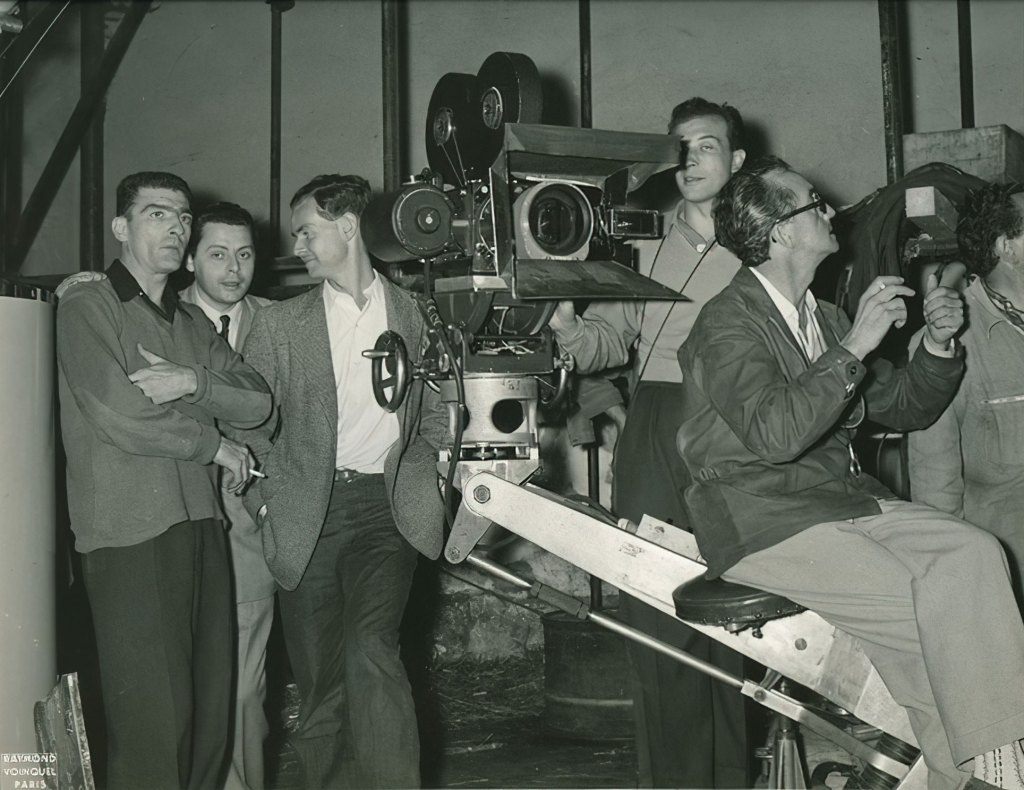
Links
The Rising of the Moon


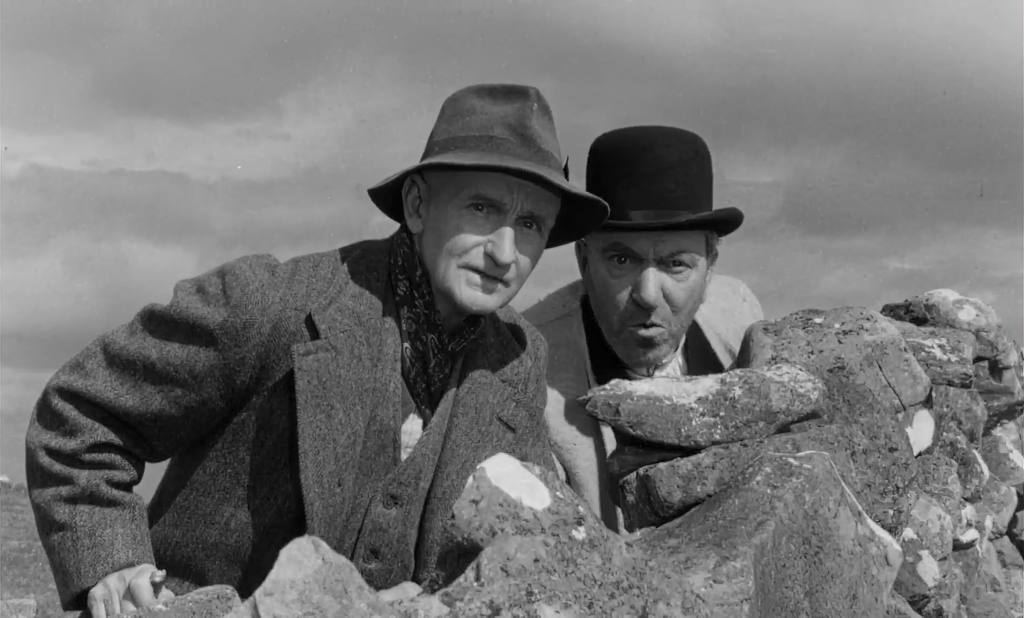
Republic of Ireland 1956
Synopsis: Three stories examine the lives of the Irish living under British oppression. – TCM
Four Provinces Productions; released by Warner Bros; produced by Michael Killanin; after the stories by Lady Augusta Gregory, The Rising of the Moon, by Michael J. McHugh A Minute’s Wait and Frank O’Connor The Majesty and the Law; written by Frank S. Nugent.
Directed by John Ford.
Film type & format: Black and white.
Director of Photography: Robert Krasker, BSC; Camera Operator: Denys Coop; Music: Eamonn O’Gallagher; Film Editor: Michael Gordon; Art Director: Raymond Simm; Assistant Director: Dennis Bertera; Costumes: Jimmy Bourke; Makeup: Colin Garde; Sound recordist: Basil Fenton-Smith, Len Shelton; Sound Editor: Lionel Selwyn; Production Manager: Edward Joseph; Technical Advisers: Ernie O’Malley, Patrick Scott; Continuity: Angela Martelli.
Cast: Tyrone Power (narrator), Maureen Connell, May Craig, Eileen Crowe, Cyril Cusack, Maureen Cusack, Maureen Delaney, Donal Donnelly, Paul Farrell, Harold Goldblatt, Frank Lawton, Edward Lexy, Jack MacGowran, Doreen Madden, Denis O’Dea, Jimmy O’Dea, Joseph O’Dea, Michael O’Duffey, Maureen Potter, Noel Purcell, Geoffrey Quigley, Tony Quinn, Anita Sharp Bolster, Michael Trubshawe and Players from the Abbey Theatre Company.
Duration: 81 minutes.
First night: 16 May 1957, Metropole Cinema, Dublin International Film Festival, Republic of Ireland.
Dates & locations: Filmed in thirty-five shooting days from March to May 1956 in and near Dublin, Ireland.
Links
- IMDb – The Rising of the Moon
- Wikipedia – The Rising of the Moon
The Story of Esther Costello

Also known as The Golden Virgin
Great Britain 1956
Synopsis: Eighteen-year-old Esther has been deaf and blind since the accident which killed her mother. Wealthy Margaret Landi, a native of Esther’s village in Ireland, is talked into helping to educate and possibly heal Esther. Margaret grows to love Esther as a daughter, but finds Esther’s innocence threatened by sleazy promoters and her own sleazy ex-husband. – IMDb
Romulus Films (GB); released through Columbia Pictures; produced by Jack Clayton, David Miller, Joan Crawford and John Woolf; after the Novel by Nicholas Monsarrat; written by Charles Kaufman.
Directed by David Miller.
Film type & format: Black and white, 1.37:1.
Director of Photography: Robert Krasker, BSC; Camera Operator: John Harris; Focus Puller: Ronnie Maasz; Music: Georges Auric; conducted by: Lambert Williamson; Editor: Ralph Kemplen; Art Director: George Provis, Tony Masters; Costumes: Julie Harris, Jean Louis (for Miss Crawford); Assistant Director: Peter Bolton, Roger Good; Unit Manager: Robert Sterne; Dubbing Editor: Gerry Hambling; Sound: John Cox (supervision), Peter Handford, Red Lamb; Makeup: George Partleton; Hairdresser: Ida Mills; Production Manager: Raymond Anzarut; Continuity: Doreen Francis.
Cast: Joan Crawford, Rossano Brazzi, Heather Sears, Lee Patterson, Ron Randell, Fay Compton, John Loder, Denis O’Dea, Sidney James, Bessie Love, Robert Ayres, Maureen Delaney, Harry Hutchinson, Tony Quinn, Janina Faye.
Duration: 102 minutes.
First night: 13 August 1957.
Dates & locations: Filmed from August 20th to early December 1956 at Shepperton Studios, London with exteriors in Ireland and England.


Links
- IMDb – The Story of Esther Costello
- Wikipedia – The Story of Esther Costello
The Quiet American

Also known as Vier Pfeifen Opium
USA 1957
Synopsis: A young naive American and a cynical older British diplomat disagree over politics in 1952 Vietnam and over a beautiful young native girl. – IMDb
Figaro Productions Incorporated (US); released through United Artists; after the Novel by Graham Greene; written by Joseph L. Mankiewicz.
Directed by Joseph L. Mankiewicz.
Film type & format: Black and white, 1.66:1.
Director of Photography: Robert Krasker, BSC; Camera Operators: John Harris, Ronnie Maasz (assistant camera, uncredited); Music: Mario Nascimbene; Music Director: Franco Ferrara; Production Manager: Forrest E. Johnston; Production Assistant: Vinh Noan, Michael Waszynski, Joseph L. Mankiewicz (uncredited); Film Editor: William Hornbeck; Settings: Rino Mondellini; Set Dressing: Dario Simoni, Italo Tomassi; Makeup: George Frost; Assistant Director: Bernhard Vorhaus; Sound: Basil Fenton-Smith; Special Effects: Roscoe Cline; Stunts: William W. Willingham; Continuity: Elaine Schreyeck.
Cast: Audie Murphy, Michael Redgrave, Claude Dauphin, Giorgia Moll, Bruce Cabot, Fred Sadoff, Kerima, Richard Loo, Peter Trent, Georges Bréhat, Clinton Anderson, Yoko Tani.
Duration: 122 minutes.
First night: 5 February 1958.
Dates & locations: Filmed from January 28, 1957 to end of April 1957 in Saigon, Tay Ninh, Vietnam and then until June 6, 1957 at Cinecittà Studios, Rome.
Links
- IMDb – The Quiet American
- Wikipedia – The Quiet American
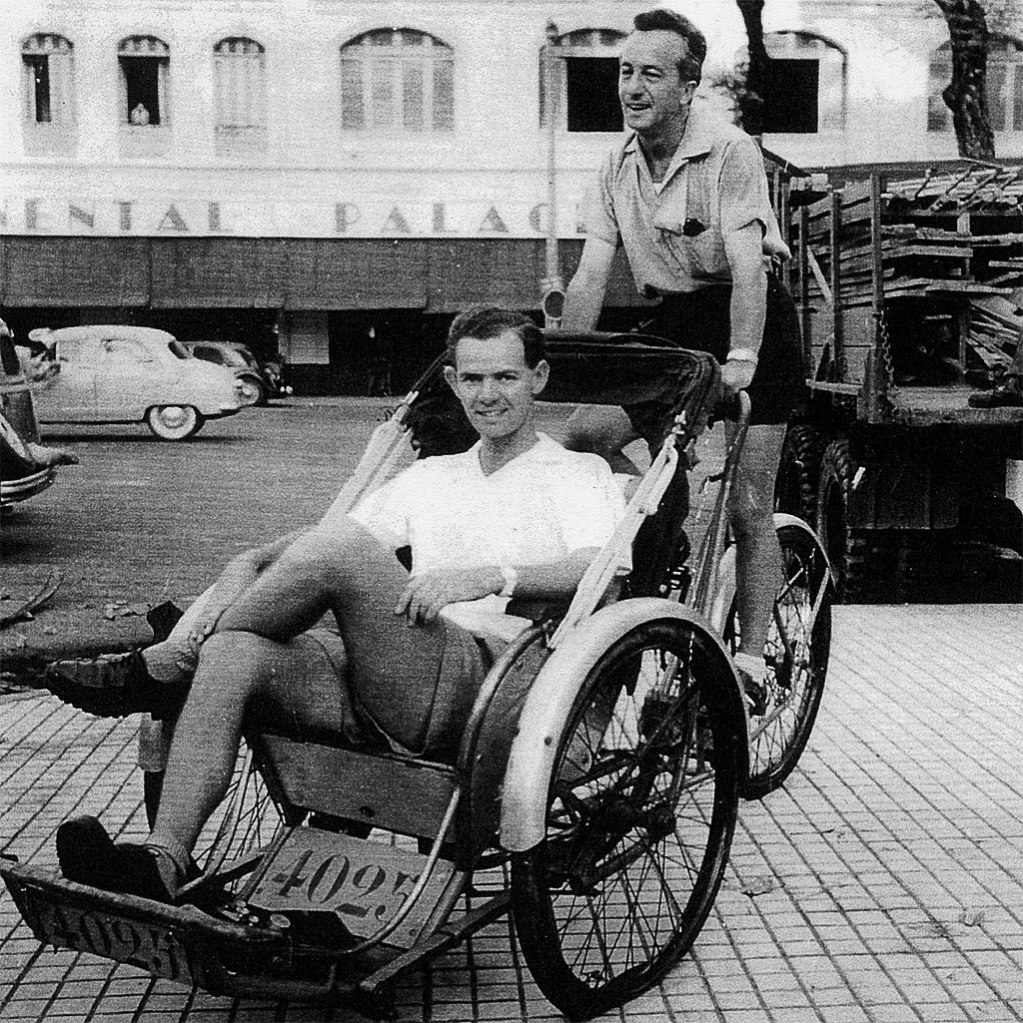
Behind the Mask

Also known as Hinter der Maske
Great Britain 1957
Synopsis: Newly qualified surgeon takes the blame for his drug addict colleague after the death of their patient through neglect. – IMDb
GW Films (GB); released through British Lion Film Corp.; produced by Sergei Nolbandov, Josef Somlo; After the novel by John Hunter The Pack; written by John Rowan Wilson.
Directed by Brian Desmond Hurst.
Film type & format: Eastmancolor, 1.66:1.
Director of Photography: Robert Krasker, BSC; Camera Operator: John Harris; Music: Geoffrey Wright, conducted by Muir Mathieson; Production Manager: R.L.M. Davidson Production Design: William Kellner; Film Editor: Allan Morrison; Casting: Thelma Graves; Costumes: Cynthia Tingey; Wardrobe: Barbara Gilette, Bernard Brian; Makeup: Michael Morris; Hairdressing: Eileen Warwick; Assistant Director: Peter Bolton, Colin M. Brewer; Sound: A.G. Ambler, John Cox; Dubbing Editor: Peter Musgrave; Continuity: Yvonne Axeworthy.
Cast: Michael Redgrave, Tony Britton, Carl Möhner, Niall MacGinnis, Vanessa Redgrave, Ian Bannen, Brenda Bruce, Lionel Jeffries, Miles Malleson, John Welsh, Ann Firbank, John Gale, Hugh Miller, Mary Skinner, Margaret Tyzak, Victor Spinetti, Graham Curnow.
Duration: 99 minutes.
First night: October 1958, USA.
Dates & locations: Filmed in autumn 1957 at Shepperton Studios, Shepperton, Middlesex, England.
Links
- IMDb – Behind the Mask
- Wikipedia – Behind the Mask
The Doctor’s Dilemma

Also known as Arzt am Scheideweg
Great Britain 1958
Synopsis: A single doctor about to be awarded a knighthood for his claim of curing tuberculosis is infatuated by a woman’s beauty and charm, promising to save her husband’s life, only to change his mind after discovering the man’s immoral character. – IMDb
de Grunwald Prod. (GB), MGM British Studios; released through Metro-Goldwyn-Mayer; produced by Anatole de Grunwald, Pierre Rouve; after the play by George Bernard Shaw The Doctor’s Dilemma; written by Anatole de Grunwald.
Directed by Anthony Asquith.
Film type & format: Metrocolor, 1.66:1.
Director of Photography: Robert Krasker, BSC; Camera Operator: John Harris; Assistant: Ronnie Maasz; Music: Joseph Kosma; Music Director: Charles Williams; Film Editor: Gordon Hales; Art Director: Paul Sheriff, Terence Morgan II, Elven Webb; Costumes: Cecil Beaton, Felix Evans; Makeup: Anne Box, Bill Lodge; Production Manager: Roy Parkinson; Assistant Director: Kip Gowans; Sound: Ben Brightwell, Peter Davies, Richard Marden, A.W. Watkins; Administration Manager: Arthur Davey; Continuity: Betty Harley.
Cast: Leslie Caron, Dirk Bogarde, Alastair Sim, Robert Morley, John Robinson, Felix Aylmer, Michael Gwynn, Maureen Delaney, Alec McCowen, Colin Gordon, Gwenda Ewen, Terence Alexander, Derek Prentice, Pater Sallis, Clifford Buckton, Mary Reynolds.
Duration: 99 minutes.
First night: 17 December 1958, USA.
Dates & locations: Filmed from mid-May 1958 to July 6th 1958 at MGM Borehamwood Studios, Hertfordshire, England.
Links
- IMDb – The Doctor’s Dilemma
- Wikipedia – The Doctor’s Dilemma
Have Jazz Will Travel: London
Great Britain 1958
Produced by Ron Rowson Associates.
Directed by Dick (Richard) Lester.
Film type & format: Black and white, 1.37:1.
Director of Photography: Robert Krasker, BSC; Production Manager: Roy Baird; Assistant Director: John Comfort; Script Supervisor: Jane Buck; Editor: Frank Goulding; Sound Recordist: Cyril Collick , with Chris Barber Band, Tony Kinsey Quartet.
Location: Filmed on location at Jeff Kruger’s Flamingo Club, London.
The Sound of Jazz
Great Britain 1958
Produced by Ron Rowson Associates.
Directed by Dick (Richard) Lester.
Film type & format: Black and white, 1.37:1.
Director of Photography: Robert Krasker, BSC; Production Manager: Roy Baird; Assistant Director: John Comfort; Script Supervisor: Jane Buck; Editor: Frank Goulding; Sound Recordist: Cyril Collick, with Tony Kinsey Quartet.
Location: Filmed on location at Jeff Kruger’s Flamingo Club, London.
Libel
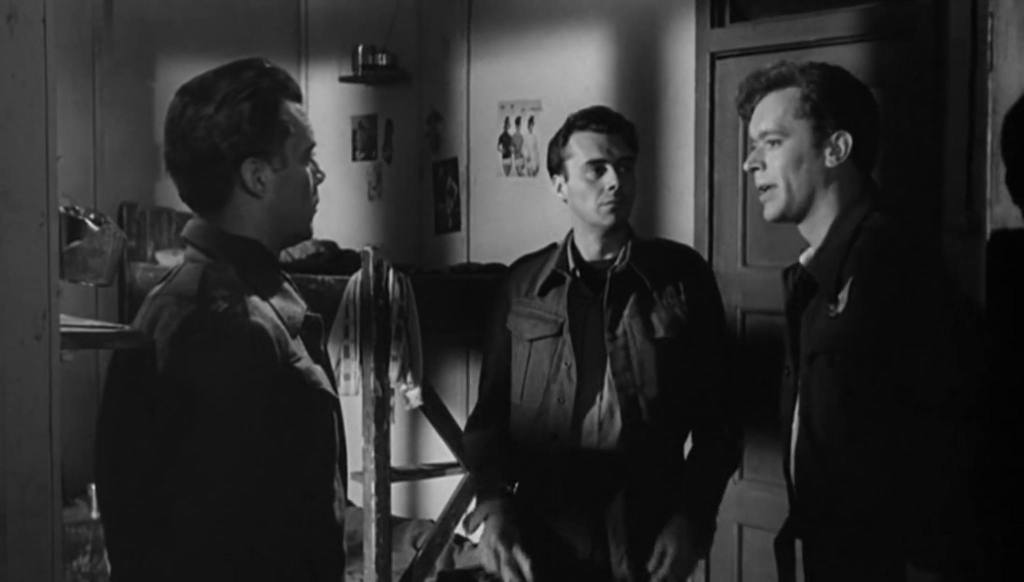
Also known as Die Nacht ist mein Feind
Great Britain 1959
Synopsis: A shell-shocked World War II veteran with memory problems is accused of being an impostor by a former comrade. – IMDb
de Grunwald Productions, MGM British Studios; released through MGM; produced by Anatole de Grunwald; after the play by Edward Wooll; written by Anatole de Grunwald and Karl Tunberg.
Directed by Anthony Asquith.
Film type & format: Black and white, Metrocolor.
Director of Photography: Robert Krasker, BSC; Camera Operator: Denys Coop; 2nd Unit Operator: Douglas Adamson; Music: Benjamin Frankel; Associate Producer: Pierre Rouve; Production Administrator: Arthur Davey; Production Manager: Roy Parkinson; Film Editor: Frank Clarke; Casting: Irene Howard; Art Director: Paul Sheriff; Set Director: Maurice Fowler; Hairdresser: Joan Johnstone; Makeup: Bill Lodge; Production Manager: Roy Parkinson; Assistant Director: David Middlemas; Sound: A. W. Watkins (Supervisor); Sound Recordist: Gerry Turner; Sound Editor: Robert Carrick, Dubbing Mixer: J. B. Smith; Visual Effects: Tom Howard; Costumes: Christian Dior (for de Havilland); Wardrobe Supervisor: Felix Evans; Continuity: Betty Harley.
Cast: Dirk Bogarde, Olivia de Havilland, Paul Massie, Robert Morley, Wilfrid Hyde-White, Anthony Dawson, Richard Wattis, Richard Dimbleby, Martin Miller, Millicent Martin, Toke Townley, Deering Wells, Bill Shine, Ivan Samson, Sebastian Saville, Richard Pearson, Robert Shaw, Geoffrey Bayldon, Gordon Sterne, Arthur Howard, Joyce Carey, Josephine Middleton, Kenneth Griffith, Barbara Archer, Anthony Doonan, Vanda Hudson, Sam Kydd.
Duration: 100 minutes.
First night: 23 October 1959.
Dates & locations: Filmed from early March to mid-April 1959 at Longleat House, Wiltshire and MGM Borehamwood Studios, Hertfordshire, England.
Links
Romanoff and Juliet

USA 1959
Synopsis: A tiny, otherwise,inconsequential and powerless European country called Concordia holds the deciding vote in a crucial United Nations resolution. As the US and Soviet Union try to manipulate Condordia so that its vote aligns with their interests, Concordia’s wily leader turns the tables on the superpowers, pitting one against the other by playing matchmaker between the son of the Soviet Ambassador and the daughter of his US counterpart. – IMDb
Pavla Prod. (US); released by Universal Pictures; produced by Walter Thompson and Peter Ustinov; written after his own play by Peter Ustinov.
Directed by Peter Ustinov.
Film type & format: Technicolor.
Director of Photography: Robert Krasker, BSC; Camera Operator: John Harris; Music: Mario Nascimbene; Film Editor: Renzo Lucidi; Art Director: Alexandre Trauner, Italo Tomassi; Set Dresser: Maurice Barnathan; Costumes: Annalisa and Orietta Nassalli-Rocca; Sandra Dee’s Costumes: Bill Thomas; Makeup: Giuseppe Annunziata, Jack Freeman; Hair: Larry Germain; Production Manager: Edward Muhl, Edward Woehler, Orazio Tassara; Assistant Director: Gus Agosti, Franco Cirino; Sound: Sash Fisher; Continuity: Yvonne Axeworthy.
Cast: Peter Ustinov, Sandra Dee, John Gavin, Akim Tamiroff, Alix Talton, Rik van Nutter, John Phillips, Peter Jones, Tamara Shayne, Suzanne Cloutier, Edward Atienza, Carl Don, John Alderson, Moura Budberg, Edward Atienza, Thomas Chalmers, Tony Selwart, Renato Chiantoni, Booth Colman, Strelsa Brown.
Duration: 103 minutes.
First night: June 1961 Germany, Berlin Film Festival.
Dates & locations: Filmed in Todi, Italy and Cinecitta Studios Rome from June to August 1959.
Links
- IMDb – Romanoff and Juliet
- Wikipedia – Romanoff and Juliet
The Criminal

Also known as The Concrete Jungle, Die Spur führt ins Nichts
Great Britain 1960
Synopsis: Even behind bars, a convict refuses to tell his cohorts where he stashed the loot from a big job. – TCM
Merton Park Studios Productions; released through Anglo Amalgamated Film Distributors; produced by Nat Cohen, Jack Greenwood, Stuart Levy; written by Alun Owen and Jimmy Sangster (uncredited).
Directed by Joseph Losey.
Film type & format: Black and white.
Director of Photography: Robert Krasker, BSC; Camera Operators: John Harris, Peter Jessop; Assistant Camera: Brian Blarney; Music: Johnny Dankworth and his orchestra, sung by Cleo Laine; Assistant Producer: Jim O’Connolly; Film Editor: Reginald Mills, Geoffrey Muller; Casting: Ronnie Curtis; Production Design: Richard Macdonald; Art Director: Scott Mac Gregor, John Graysmark, Len Townsend; Makeup: George Partleton, Jack Craig; Hairdresser: Helen Penfold; Production Manager: Bill Shore; Assistant Director: Buddy Booth; 2nd Assistant Director: Neil Vine-Miller; 3rd Assistant Directors: Timothy Burrill, John Quested; Sound: Ronald Abbott, Sidney Rider, Arthur Vincent; Sound Editor: Derek Holding; Still Photographer: Eddie Orton; Costumes: Ron Beck, Laura Nightingale; Continuity: Pamela Davies.
Cast: Stanley Baker, Sam Wanamaker, Margit Saad, Grégore Aslan, Jill Bennett, Rupert Davies, Laurence Naismith, John Van Eyssen, Noel Willman, Derek Francis, Redmond Phillips, Patrick Magee, Edward Judd, Dorothy Bromiley, Neil McCarthy, Nigel Green, Kenneth J. Warren, Brian Phelan, Jack Rodney, Paul Stassino, Patrick Wymark, Tom Bell.
Duration: 92 minutes.
First night: 17 March 1961.
Dates & locations: Filmed in London at Merton Park Studios in spring and summer 1960.
Links
- IMDb – Concrete Jungle
- Wikipedia – The Criminal
El Cid
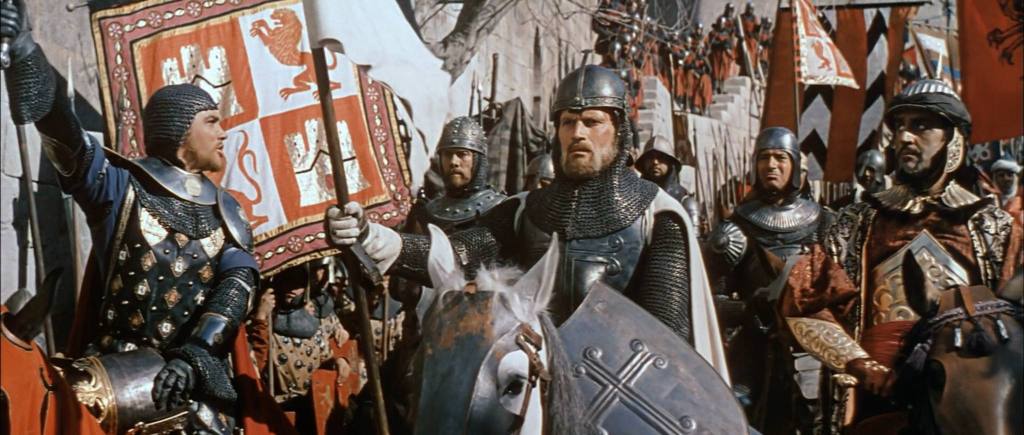
Italy/USA 1960/61
Synopsis: Epic film of the legendary Spanish hero, Rodrigo Diaz (“El Cid” to his followers), who, without compromising his strict sense of honour, still succeeds in taking the initiative and driving the Moors from Spain. – TCM
Rank Organisation, Samuel Bronston Productions (US), Dear Film, Rome; released through Allied Artists (US), Rank Org. (GB); produced by Samuel Bronston; after the story by Frederik M. Frank; written by Philip Yordan, Frederik M. Frank and Ben Barzman, Italian version: Diego Fabbri.
Directed by Anthony Mann.
Film type & format: Technicolor, 70mm Super Technirama, 2.20:1, 2.35:1 (different sites give different aspect ratios).
Director of Photography: Robert Krasker, BSC; Camera Operator: John Harris; Director of Photography, 2nd Unit: Manuel Berenguer; Clapper Boy: Robin Browne; Head Grip: Carl Gibson; Supervising Electrician: Norton Kurland, Bruno Pasqualini; Music: Miklos Rosza; Music Director: Eugene Zador; Associate Producers: Jaime Prades and Michael Waszynski; Producer: Robert Haggiag; Film Editor: Robert Lawrence; Assistant: Magdalena Paradell; Set Decoration, Production and Costume Designers: Veniero Colasanti, John Moore; Art Department: Stanley Detlie (Property Master), Maciek Piotrowski (Paintings and Drawings), José Maria Alarcón, Julian Martin, Vicente Sempere; Wardrobe Director: Gloria Musetta; Makeup: Mario van Riel; Hair Styles: Grazia de Rossi; Production Manager: Leon Chooluck, Guy Luongo, Tadeo Villalba; First Assistant Director: Luciano Sacripanti; Assistant Director: José Lopez Rodero, José Maria Ochoa, Julio Sempere, Technicolor Consultant: George Minassian; 2nd Unit Director: Yakima Canutt; Sound: Jack Solomon; Re-Recording: Gordon McCallum; Sound Editor: Verna Fields; Music Editor: Edna Bullock; Special Effects: Jack Erickson, Alex Weldon; Stunt Coordinator: Enzo Musumeci Greco; Stunts: Buff Brady, Jerry Brown, Joe Canutt, Tap Canutt, Enzo Greco, Jack Williams; Script Supervisor: Pat Miller.
Cast: Charlton Heston, Sophia Loren, Raf Vallone, Genevieve Page, John Fraser, Gary Raymond, Hurd Hatfield, Massimo Serato, Frank Thring, Michael Hordern, Andrew Cruikshank, Douglas Wilmer, Tullio Carminati, Ralph Truman, Christopher Rhodes, Carlo Giustini, Gerard Tichy, Fausto Tozzi, Barbara Everest, Katina Noble, Nelio Bernardi, Franco Fantasia, Herbert Lom.
Duration: 184 minutes.
First night: 24 October 1961, Italy.
Dates & locations: Filmed from mid-November 1960 in Spain – Belmonte, Cuenca, Calahorra-Logrono, Ciudad Real, February 1961 at Peniscola-Castellon, Toledo, Valladolid, and in Estudios Chamartin, Madrid, three weeks in Rome, Titanus Appia Studios, filming ended April 1961.
Awards: Awarded best cinematography in 1961 by British Society of Cinematographers (BSC).
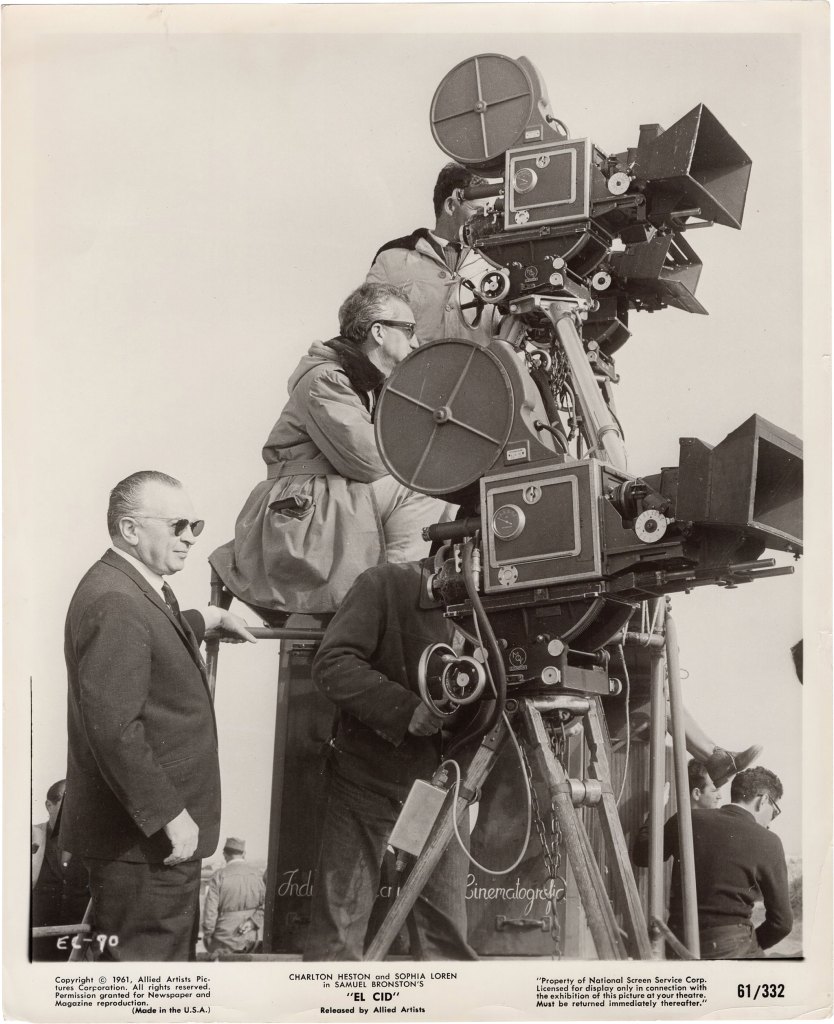
Links
Billy Budd

Also known as Die Verdammten der Meere
Great Britain 1961
Synopsis: Adaptation of Herman Melville’s classic tale of a ship’s captain caught between an innocent young sailor and an evil officer. – TCM
Allied Artists Pictures Corporationn, Harvest Films (GB); released through Allied Artists, Warner Bros (US); produced by A. Ronald Lubin (Executive Producer), Peter Ustinov; after the novel Billy Budd, Foretopman by Herman Melville and the play by Louis O. Coxe and Robert H. Chapman; written by Peter Ustinov, DeWitt Bodeen and Robert Rossen.
Directed by Peter Ustinov.
Film type & format: Black and white, CinemaScope, 2.35:1.
Director of Photography: Robert Krasker, BSC; Camera Operators: John Harris, Bernard Ford and Kelvin Pike (Focus Pullers); Clapper Loader: Simon Ransley; Maintenance: Tommy Jones; Stills: George Higgins; Music composed and conducted by Antony Hopkins, played by the Philharmonia Orchestra; Production Associate: Arthur S. Ferriman; Film Editor: Jack Harris; Casting Director: Robert S. Lennard; Production Designer: Donald M. Ashton; Art Director: Peter Murton; Construction Manager: Stanley Gale; Costumes: Anthony Mendleson; Wardrobe: Ron Beck, Laura Nightingale; Makeup: Bob Lawrence; Assistant: Sid Turner; Hair Dresser: Harry Montsash; Assistant: Patricia McDermott; Production Supervisor: Albert Jaeger; Production Manager: Victor Peck; Assistant Director: Michael Burkett, Claude Watson; Sound Recordists: Charles Poulton, Len Shilton; Sound Editor: Charles Crafford; Special Effects: George Blackwell, Fred Heather, Garth Inns, Curly Nelhams; Stunts: Ken Buckle, Joe Powell; Production Secretary: Joan Parcell, Mary-Ann Ferriman; Continuity: June Faithfull, Technical Advisor: Capt. Alan Villiers
Cast: Robert Ryan, Peter Ustinov, Terence Stamp, Melvyn Douglas, Paul Rogers, John Neville, David McCallum, Ronald Lewis, Lee Montague, Thomas Heathcote, Ray McAnnally, Robert Brown, John Meillon, Cyril Luckham, Niall McGinnis, Victor Brooks, Barry Keegan, Suzanne Cloutier.
Duration: 123 minutes.
First night: 12 November 1962, USA.
Dates & locations: Filmed from May 1961 for six weeks in Alicante in Spain then six weeks at Elstree studios in London.
Awards: Terence Stamp nominated for best supporting actor for Oscar.
Links
- IMDb – Billy Budd
- Wikipedia – Billy Budd
Guns of Darkness
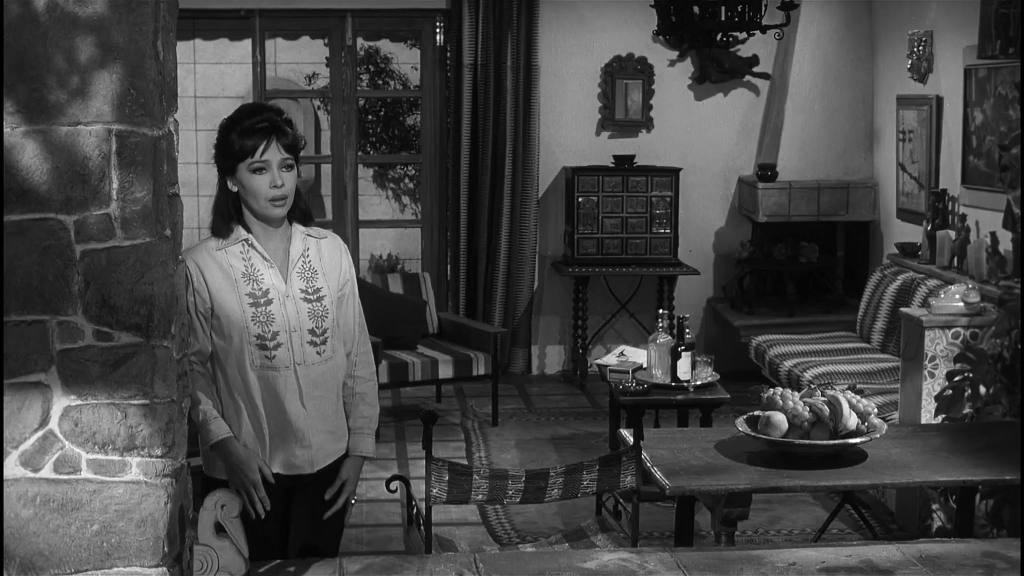
Great Britain 1961
Also known as Act of Mercy, Flucht aus dem Dunkel
Synopsis: A businessman and his wife are caught in the turmoil of a South American revolution. – TCM
Associated British Picture Corporation (ABPC), Cavalcade Films (GB), Concorde released through Warner Bros.; produced by Thomas Clyde; after the novel An Act of Mercy by Francis Clifford; written by John Mortimer.
Directed by Anthony Asquith.
Film type & format: Black and white.
Director of Photography: Robert Krasker, BSC; Camera Operator: Gerry Fisher; Additional Photographer: Harold Haysom; Music: Benjamin Frankel; Executive Producer: Ben Kadish; Film Editor: Frederick Wilson; Art Director: John Howell; Assistant Director: David Tomblin; Casting Director: Robert Lennard; Assistant: David Booth; Costumes: Anthony Mendleson; Makeup: Jim Hydes; Hairdresser: Patricia McDermott; Production Controller: Tom White; Production Manager: Victor Peck; Assistant: Pedro Vidal; Sound Recordist: Norman Coggs, Len Shilton; Sound Editor: Charles Crafford; Recording Director: A. W. Lumkin; Continuity: Betty Harley.
Cast: Leslie Caron, David Niven, David Opatoshu, James Robertson Justice, Eleanor Summerfield, Ian Hunter, Derek Godfrey, Richard Pearson, Sandor Elès, Steven Scott, Tutte Lemkow, Dotita Sensier, John Carson, Ali Nagi, Barry Shawzin, Peter Allenby, Robert Barnette, Molino Rojo, Juan Cazallia, Ralph Nossek, Clive Cazes, Neville Becker.
Duration: 102 minutes.
First night: 17 August 1962, USA.
Dates & locations: Filmed in five weeks in autumn of 1961 in Malaga, Spain.
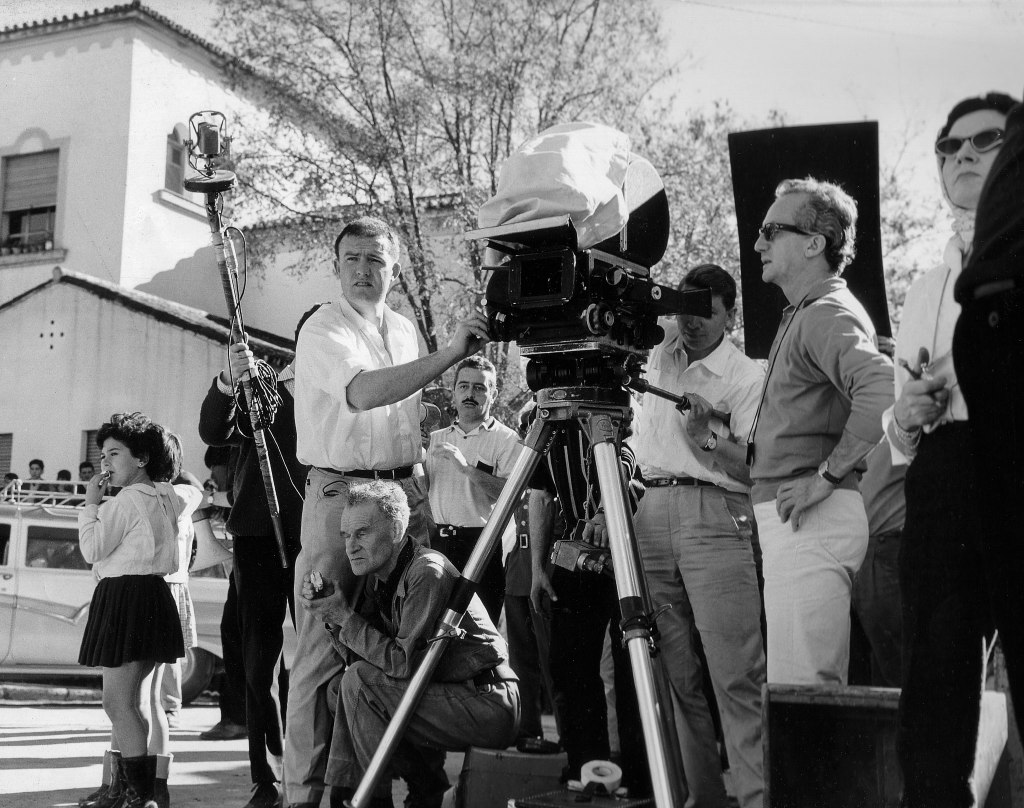

Links
- IMDb – Guns of Darkness
- Wikipedia – Guns of Darkness
The Running Man

Also known as Der zweite Mann
Great Britain 1962
Synopsis: A man fakes his death to get back at the insurance company that denied an earlier claim. – TCM
Peet Productions (GB); released through Columbia; produced by Carol Reed and John R. Sloan (Associate Producer); after the novel by Shelley Smith The Ballad of the Running Man; written by John Mortimer.
Directed by Carol Reed.
Film type & format: Eastman Color by Pathé, Panavision, 2.35:1.
Director of Photography: Robert Krasker, BSC; Camera Operator: John Harris; Music: William Alwyn, conducted by Muir Mathieson, played by Sinfonia of London, title Music: Ron Grainer; Editor: Bert Bates; Art Director: John Stoll; Assistant: Herbert Smith; Makeup: George Frost; Hairdresser: George Scott; Production Supervisor: John Dark; Spanish Production Manager: Roberto Roberts; Unit Manager: John Quested; Assistant Director: Peter Bolton, Pedro Vidal; 2nd Unit Director: Harold Haysom; Sound: Claude Hitchcock, Bob Jones; Sound Editor: Peter Thornton; Continuity: Angela Allen; Title Designer: Maurice Binder.
Cast: Laurence Harvey, Lee Remick, Alan Bates, Felix Aylmer, Eleanor Summerfield, Colin Gordon, Allan Cuthbertson, Harold Goldblatt, Noel Purcell, Ramsay Ames, Fernando Rey, Juan Jose Menendez, Eddie Byrne, John Meillon, Roger Delgado, Fortunio Bonanova, Shirley Gale, Jose Calvo, Joe Lynch, Freddy Roberts, Adriano Dominguez, James Neyland, Pamela Mant, Herbert Curiel, Antonio Padilla Ruiz, Lockwood West, Bob Cunningham.
Duration: 103 minutes.
First night: September 1963.
Dates & locations: Filmed from end of June 1962 in Algericas, Cadiz, Gibraltar, La Linea, San Roque, Spain and Ardmore Studios, Bray, County Wicklow, Ireland to late autumn.
Awards: Nominated for BAFTA award for best color cinematography, 1963.
Note: William Alwyn’s last film score.
Links
- IMDb – The Running Man
- Wikipedia – The Running Man
The Fall of the Roman Empire

Also known as Der Untergang des Römischen Reiches
USA 1963
Synopsis: A mad emperor’s excesses leave the Roman Empire open to barbarian invasions. – TCM
Bronston Roma Productions (US); released through Rank Org., Paramount (US); produced by Samuel Bronston; written by Ben Barzman, Basilio Franchina, Philip Yordan.
Directed by Anthony Mann.
Film type & format: Technicolor, Ultra-Panavision, 2.75:1.
Director of Photography: Robert Krasker, BSC; Camera Operator: John Harris; 2nd Unit Cameraman: Cecilio Paniagua; Clapper Boy: Robin Browne; Camera Mechanic: Roy Moores; Supervising Electrician: Bruno Pasqualini; Supervising Technician: Carl Gibson; Music composed and conducted by Dimitri Tiomkin; Associate Producer: Jaime Prades; Executive Associate Producer: Michael Waszynski; Music Editor: George Korngold; Film Editor: Robert Lawrence; Assistant: Magdalena Paradell; Casting: Maude Spector; 2nd Unit Director: Yakima Canutt; Assistant: Andrew Marton; Set Decorators, Production and Costume Designers: Veniero Colasanti, John Moore; Scenic Artist: Italo Tomassi; Title back-ground and murals: Maciek Piotrowski; Costumes: Cernatelli & Peruzzi, Italy; Wardrobe: Gloria Musetta; Makeup: Mario van Riel; Hairdressing: Grazia de Rossi; Sound Mixer: David Hildyard; Sound Re-Recording: Gordon McCallum; Sound Effects Editor: Milton Burrow; Executive Production Manager: C.O. Erickson; Assistant Director First Unit: José Lopez Rodero; Assistant Director 2nd Unit: José Maria Ochoa; Assistant Director: Julio Sempere; Special Effects: Alex Weldon; Stunts: Jerry Brown, Tap Canutt, Jack Williams; Still Photographer: Vincent Rossell; Consultant: Will Durant, Master of Properties: Stanley Detlie; Continuity: Elaine Schreyeck; Dialogue Coach: George Tyne; Master of Arms: Enzo Musumeci Greco; Horse Master: Friedrich von Ledebur.
Cast: Sophia Loren, Stephen Boyd, Alec Guinness, James Mason, Christopher Plummer, Anthony Quayle, John Ireland, Omar Sharif, Mel Ferrer, Eric Porter, Finlay Currie, Andrew Keir, Douglas Wilmer, George Murcell, Norman Wooland, Michael Gwynn, Virgilio Texera, Peter Damon, Rafael Calvo, Lena von Martens.
Duration: 188 minutes.
First night: 24 March 1964, United Kingdom.
Dates & locations: In mid-October 1962 Krasker, Harris and Mann flew to Los Angeles for a Panavision promotion then filming started 25th January 1963 at Serra Montanis near Madrid, in Valencia, Lake Satillana, Las Matras – Madrid, Manzanares el Real, Sagunto – Valencia, Segovia – Sierra de Guadarama, Spain, at Bronston Studios in Chamartin in Madrid, then filming ended in August 1963.
Links
- Wikipedia – Panavision – Panavision was co-founded by Robert E. Gottschalk in 1953.


Links
- IMDb – The Fall of the Roman Empire
- Wikipedia – The Fall of the Roman Empire
- Wikipedia – Panavision – Panavision was co-founded by Robert E. Gottschalk in 1953.
The Collector

Also known as Der Fänger
Great Britain 1964
Synopsis: A disturbed young man kidnaps a woman he’s been stalking. – TCM
Collector Company, Columbia Productions; released through Columbia; produced by Jud Kinberg and John Kohn; after the Novel by John Fowles; written by Stanley Mann, John Kohn and Terry Southers.
Directed by William Wyler.
Film type & format: Technicolor, 1.85:1.
Director of Photography: Robert Surtees (US; Studio Photography about 80% of the film), Robert Krasker, BSC (UK; all Exterior Photography); Camera Operators: Andrew McIntyre, John Harris (operator for Robert Krasker); 2nd Unit: Norman Warwick; Music: Maurice Jarre, Richard C. Harris; Production Manager: Philip Shipway; Film Editor: David Hawkins, Robert Swink; Art Director: John Stoll, Tom Plews, Robin Vaccarino; Set Director: Frank Tuttle; Makeup: Harold Fletcher (UK), Ben Lane (US), Don Schoenfeld (US); Hair: Virginia Jones (US), Ruby Felker (US), Pearl Tipaldi (GB); Assistant Director: Roy Baird (UK), Sergei Petschnikoff (US); 2nd Unit Assistant Director: Robert Swink; Sound Supervisor: Charles J. Rice; Sound: Jack Solomon (US), Cyril Collick (UK), Clem Portman; Costumes: Vi Alford; Wardrobe: Brenda Dabbs, Jack Martell; Script Supervisor: Isabelle Blodgett; Dialogue Coach: Kathleen Freeman.
Cast: Terence Stamp, Samantha Eggar, Mona Washbourne, Maurice Dallmore, Allyson Ames, Gordon Barclay, William Bickley, David Haviland, Kenneth More.
Duration: 119 minutes.
First night: 17 June 1965, USA; 22 November 1965, United Kingdom.
Dates & locations: Filmed in April 1964 for four weeks in Kent, in Chilham, Edenbridge, Westerham, St. Mary’s Marshes, Mount Vernon Lane, Hampstead, Hampstead Tube Station, Trafalgar Square, London by Robert Krasker and Columbia/Sunset Gower studios, Los Angeles by Robert Surtees.
Awards: Terence Stamp won best actor 1965 Cannes, Samantha Eggar won best actress 1965 Cannes.
Links
- IMDb – The Collector
- Wikipedia – The Collector
The Heroes of Telemark

Also known as The Unknown Battle, Kennwort ‹Schweres Wasser›
Great Britain 1964/65
Synopsis: Norwegian resistance fighters try to stop Nazi experiments in nuclear warfare. – TCM
Benton Film Productions (GB); released through Rank Organisation (GB) and Columbia (US); produced by Benjamin S. Fisz; after the Novel by John Drummond and Knut Haukelid; written by Ben Barzman, Ivan Moffat and Harold Pinter.
Directed by Anthony Mann.
Film type & format: Technicolor, Panavision, 2.35:1.
Director of Photography: Robert Krasker, BSC; Camera Operators: John Burrows, John Harris, Ronnie Maasz; Focus Puller: James Davis; Clapper Loader: Michael Drew; Assistant: Socrates Pelendrides; 2nd Unit Camera and Director: Egil S. Woxholt; Head Gaffer: Vic Smith; Music composed and conducted by Malcolm Arnold; Production Supervisor: George Pitcher; Production Manager: William Kirby; Film Editor: Bert Bates; Assistants: Timothy Gee, Lindsay Hume; Casting: Maude Spector; Art Directors: Anthony Masters; Assistants: John Hoesli, Jack Maxsted; Set Director: Robert Cartwright, Ted Clements; Wardrobe: Elsa Fennell; Assistant: Gloria Barnes; Location Manager: Jimmy Komisarjevsky; Makeup: Neville Smallwood; Hair: Maud Onslow; Production Manager: Timothy Burrill; Assistant Director: Derek Cracknell, John Quested, Christopher Stamp, Jonathan Benson, Michael Douglas; Sound: Bill Daniels, Gordon McCallum; Boom Operator: Gus Lloyd; Assistant: Maurice Smith; Sound Editor: Ted Mason; Assistant: Ron Davis; Otto Snell; Special Effects: John P. Fulton, Ron Ballanger, Sidney Pearson, Bill Warrington; Stunts: Gerry Crampton, Ald Joint, Terence Plummer, Joe Powell; Wardrobe: Elsa Fennell; Continuity: Kay Mander.
Cast: Kirk Douglas, Richard Harris, Ulla Jacobsson, Michael Redgrave, Anton Diffring, Eric Porter, Mervyn Jones, Jennifer Hilray, Roy Dotrice, Barry Jones, Ralph Michael, Geoffrey Keen, Maurice Denham, Wolf Frees, Robert Ayres, Sebastian Breaks, David Davies, Karel Stepanek, Faith Brook.
Duration: 131 minutes
First night: November 1965, United Kingdom.
Dates & locations: Filmed during winter of 1964/65 in Oslo, Rjukan-Telemark, Tinnsjö in Norway and six weeks at Pinewood Studios, England.
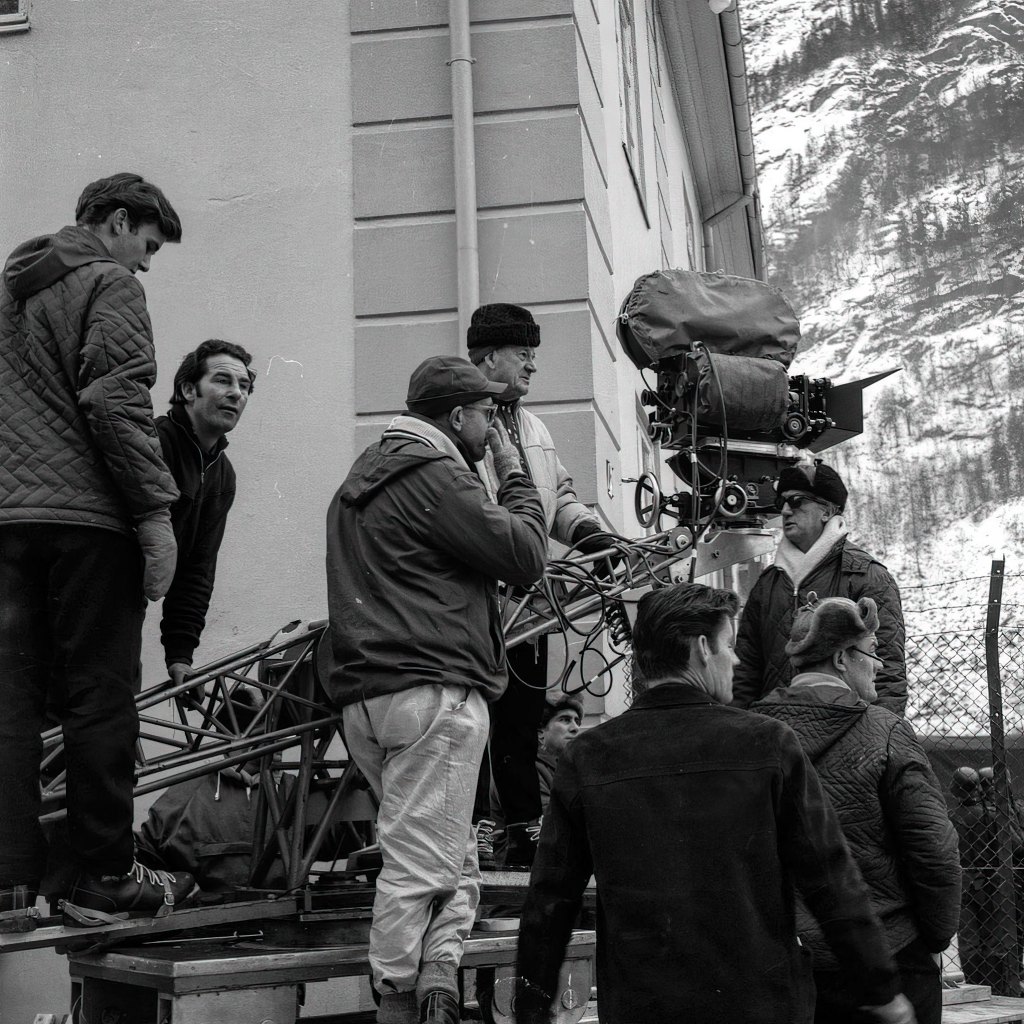

Links
- IMDb – The Heroes of Telemark
- Wikipedia – The Heroes of Telemark
The Trap

Also known as Wie ein Schrei im Wind
Great Britain 1965
Synopsis: After spending several winters alone in the Canadian wilderness, a lusty trapper returns to the trading post and buys a wife, a young mute orphan. – TCM
George H. Brown Productions (as Parallel, US); released through Rank Organisation; produced by George H. Brown, Jan Darnley-Smith, after his own screenplay; written by David D. Osborn.
Directed by Sidney Hayers.
Film type & format: Eastmancolor, Panavision, 2.35:1.
Director of Photography: Robert Krasker, BSC; Camera Operator: John Harris; Grip: Fred Ransom; 2nd Unit Camera: Osmond Borradaile; 2nd Unit Camera Assistant: Bill Boozeboom; Chief Electrician: Bill Newbery, Sid Penner; Music: Ron Goodwin; Film Editor: Tristam Cones; Casting: Jack Ammon; Art Director: Harry White, Ernest Kerr, Peter Prior, David M. Robertson, Kenneth Ryan, Charles Torbett; Costumes: Margaret Furse, Salli Bailey, Cy Cook, James Smith; Makeup: Ivy Emmerton, Richard Mills; Production Manager: Basil Keys, Barrie McLean, L.C. Rudkin.
Cast: Rita Tushingham, Oliver Reed, Barbara Chicott, Blain Fairman, Rex Sevenoaks, Linda Goranson, Jon Granik, Mery Campone, Reg McReynolds, Walter Marsh.
Duration: 106 minutes
First night: April 1966, United Kingdom.
Dates & locations: Filmed from October 1965 on Bowen Island, Pendleton, British Columbia, Canada and at Hollyburn Studios, Vancouver, Canada, filming ended 10 December 1965.
Note: The Trap has been credited by a Canadian film and television historian as kicking off serious feature film production in British Columbia.
Links
Red
Great Britain 1976
Produced for Mauro Pictures.
Directed by Astrid Frank.
Director of Photography: Robert Krasker, BSC; Drawings: Raymond Bertrand; Editor: Pat Foster; Art Director: Harry Evans; Music: Anthony Bowles; Assistant Director: Nick Farnes; Production Supervisor: Martin Campbell; Sound Recordist: David Lawton.
Cast: Ferdy Mayne, Mark Wynter, Gabrielle Darke, Steve Brownelow, Astrid Frank.
Duration: 24 minutes.
Location: Filmed at Medmenham Manor (Thames).
Gertcha

Great Britain 1979
Produced for Courage Brewery’s Courage Best Bitter; Production Company: Hudson Films; Advertising Agency: BMP (Boase Massimi Pollitt).
Directed by Hugh Hudson.
Film type & format: Black and white.
Director of Photography: Robert Krasker, BSC; Art Director: John Webster; Copywriter: Dave Trott.
Cry Wolf
Great Britain 1980
Produced for Picture Partnership Productions/Paramount Pictures Corporation; Producer: Brian Eastman; Script: Stan Hey.
Directed by Leszek Burzynski.
Director of Photography: Robert Krasker, BSC; Camera Operator: Brian Elvin; Editor: Margaret Dickinson; Production Designer: Don Taylor; Art Director: Michael Minas; Assistant Director: Simon Channing-Williams; Costumes: Monica Howe; Makeup: Tom Smith; Sound Recordist: Mervyn Gerrard; Sound Re-Recording: Hugh Strain.
Cast: Paul Maxwell, Rosalind Ayres, Stephen Greif, James Bree, Christopher Fairbank, Gabrielle Daye, Joseph Brady.
Duration: 31 minutes.
Location: Filmed at Production Village.
